There are many types of butterflies native to the United States. Most of them are multicolored but some are dominated by a single color.
The US is home to thousands of species of butterflies, each with its visual characteristics. You can find many brown butterflies or butterflies that are mainly brown in various parts of the US.
Brown can be a color butterflies adapt to according to their environment for camouflage. But it can also be a result of evolution as each species has distinct coloring and patterns on the wings.
The following species of brown butterflies are the most likely to be seen across the US.
Table of Contents
1. Common Buckeye
Common Buckeye butterflies (Junonia coenia) are native to the US. This species is dominated by brown coloring.
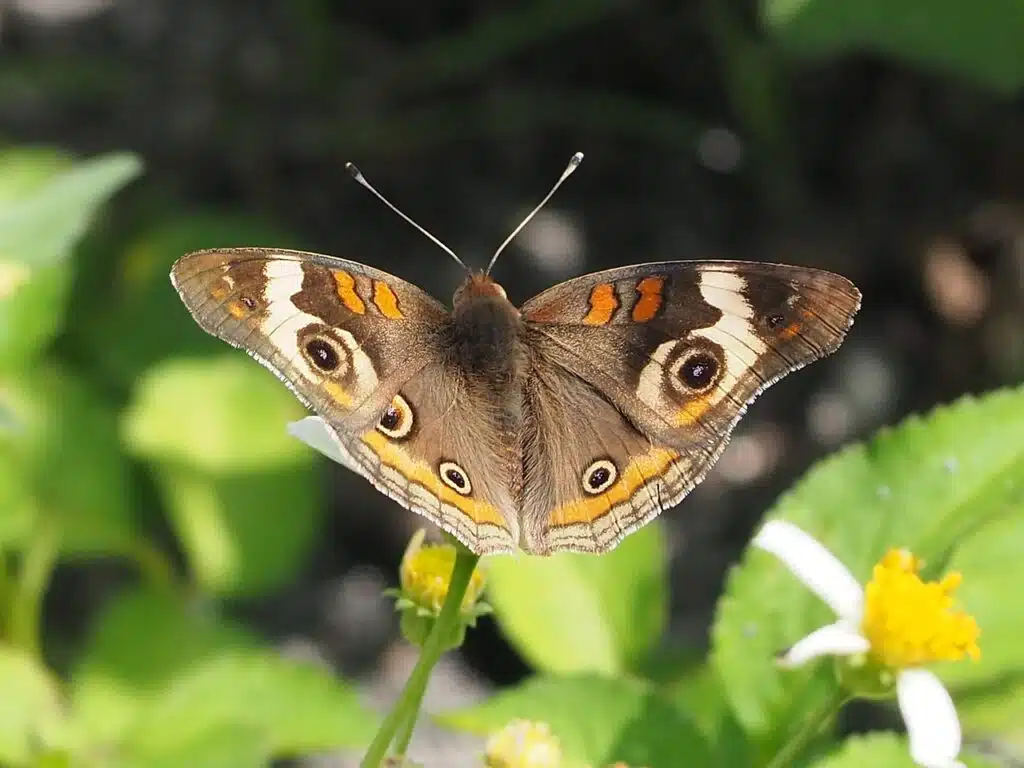
The dark brown eyespots on the wings of this species make it look distinct. There are 2 large eyespots and 2 small eyespots on each wing of the species.
Light brown coloring is the base color of the wings with light brown or tan coloring on the base of the hindwings.
This species has a dark brown body.
As seen on many US post stamps, the Common Buckeye butterfly is selective in its habitat. It only lives where it can find plants and flowers that stimulate its appetite.
2. Fiery Skipper
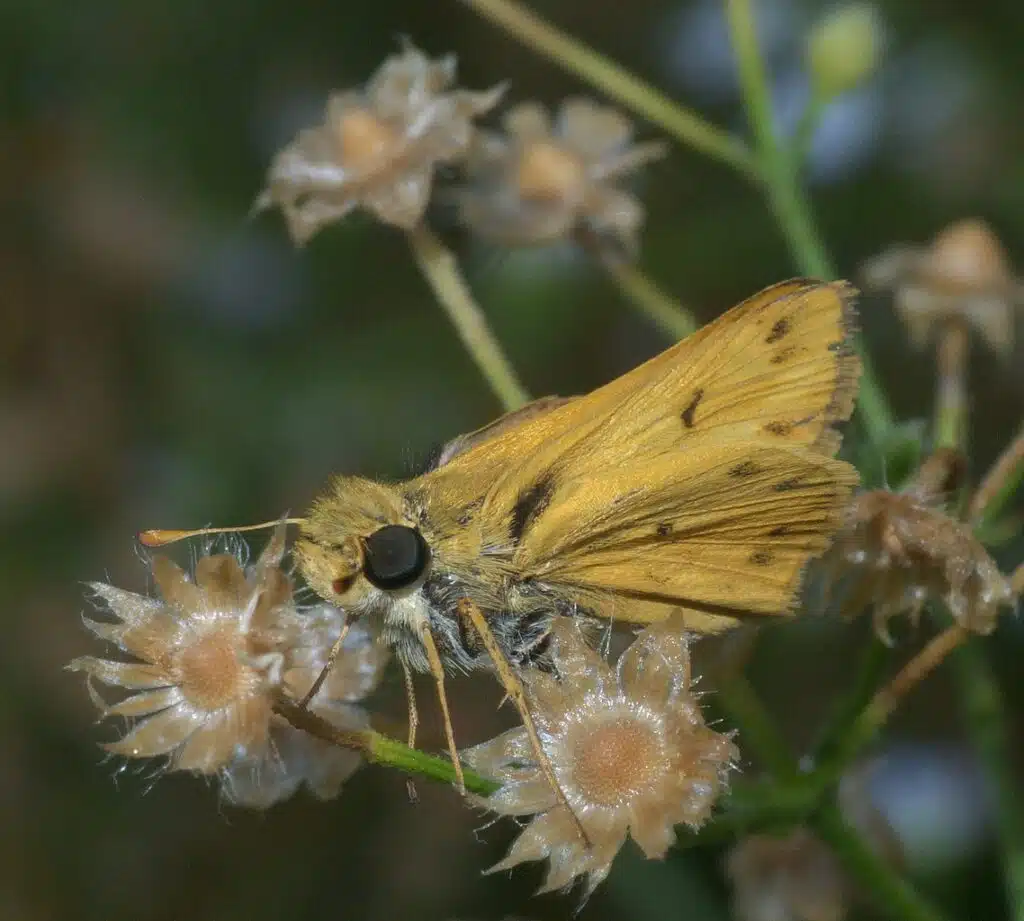
Fiery Skippers (Hylephila phyleus) are widely common as they are seen in most US states. This species isn’t the most common by numbers as it’s not even a permanent species.
But the Fiery Skipper is a migratory butterfly that is seen at least once per year in all habitats from Southern Canada to South America.
This species has small coloring differences between the sexes.
Males are closer to yellow in coloring while females are mostly brown.
Light brown, dark brown, and black coloring dominate the aspect of the female’s wings.
The inner wings of the female are light brown to yellow while the outer wings are dark brown. The body is also bright and dark brown in a color combination.
3. Silver-spotted Skipper
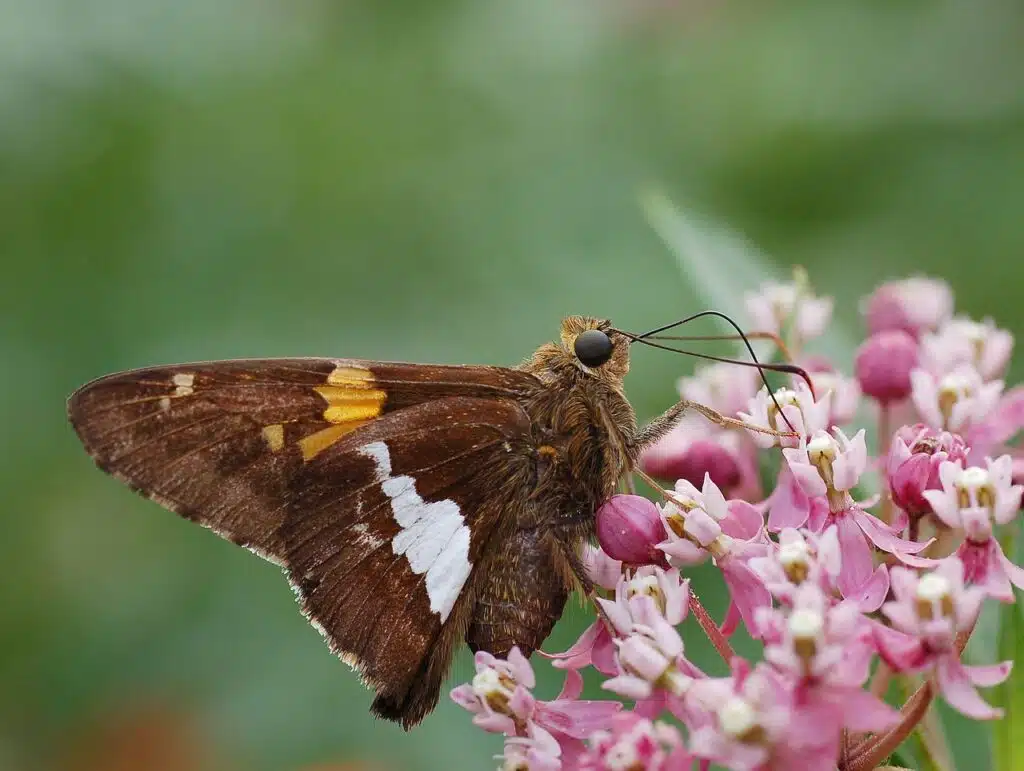
Silver-spotted Skippers (Epargyreus clarus) are another brown migratory species native to the US.
This species has small coloring differences between males and females.
Male Silver-spotted Skippers have a dark brown color with a darker brown to black hindwing nuance.
They show yellow or tan bands and marks across the upper wings. The body of the species is also brown.
Females have lighter brown coloring and rounded wings.
The broods of these species depend a lot on their habitat. The warmer the climate the more broods the Silver-spotted Skipper has.
Butterflies in the South have up to 4 broods per year compared to 1 brood per year in the Northern territories.
4. Zabulon Skipper
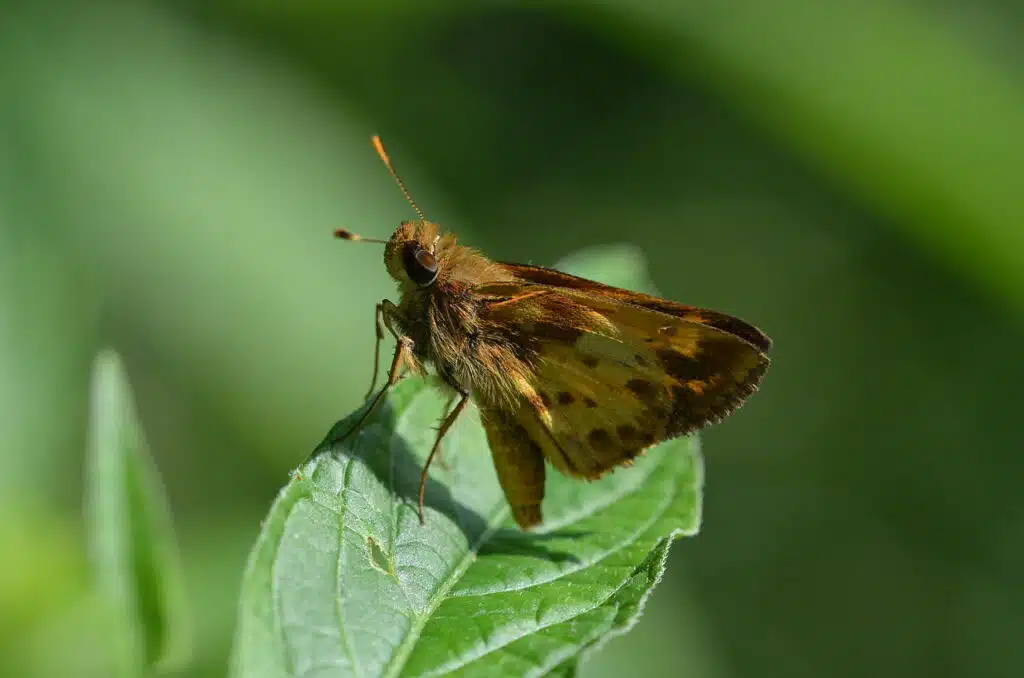
Moist woodlands and areas next to streams in the Eastern United States are the ideal habitats for the Zabulon Skipper (Lon zabulon).
This species is known for having multiple shades of brown make up the bulk of its wings.
Dark brown serves as margins for the wings while light brown is seen on the inner wings closer to the dark brown body.
Zabulon Skippers also have brown underwing coloring. Dark brown coloring is specific to the ventral side of the species.
Familiar with brushy fields and openings in woodlands, the Zabulon skipper feeds on honeysuckle and blueberries among other plants and flowers.
5. Hackberry Emperor
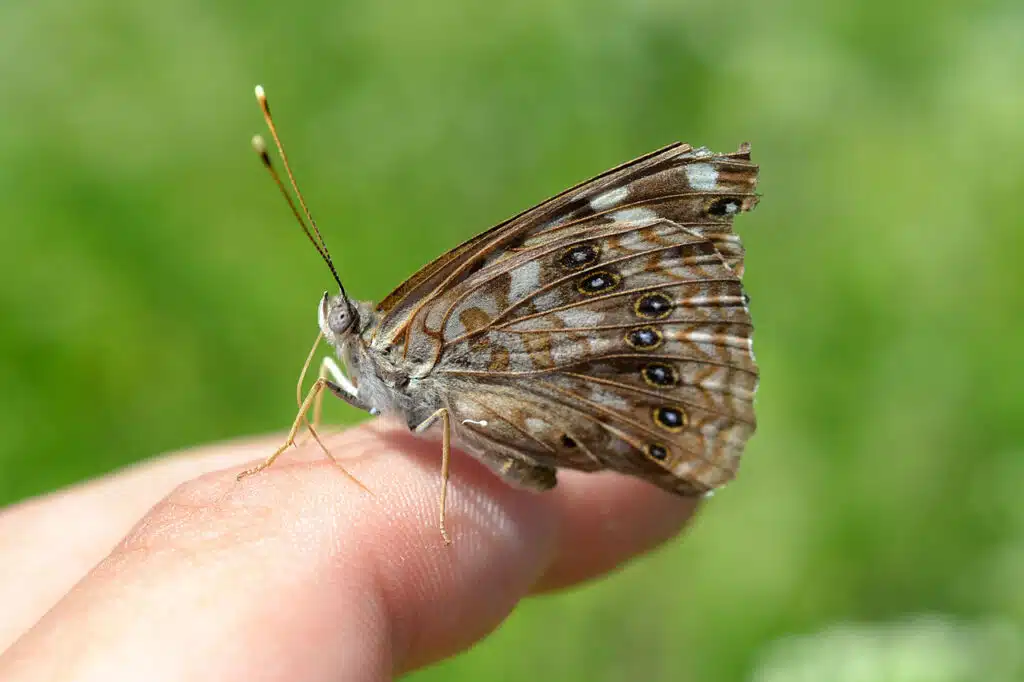
Hackberry Emperors (Asterocampa celtis) are among the rare brown butterflies in the US that don’t feed on nectar.
As their name implies, these butterflies feed on hackberry tree sap. The butterflies also feed on animal feces.
You can identify the Hackberry Emperor by its multiple shades of brown.
Darker brown patches are seen on its outer wings while its inner wings have light brown coloring. White dots are also seen across its upper wings.
The species is common around hackberries in Southeastern US states.
It mainly lives on hackberries in lowland territories.
6. Horace’s Duskywing
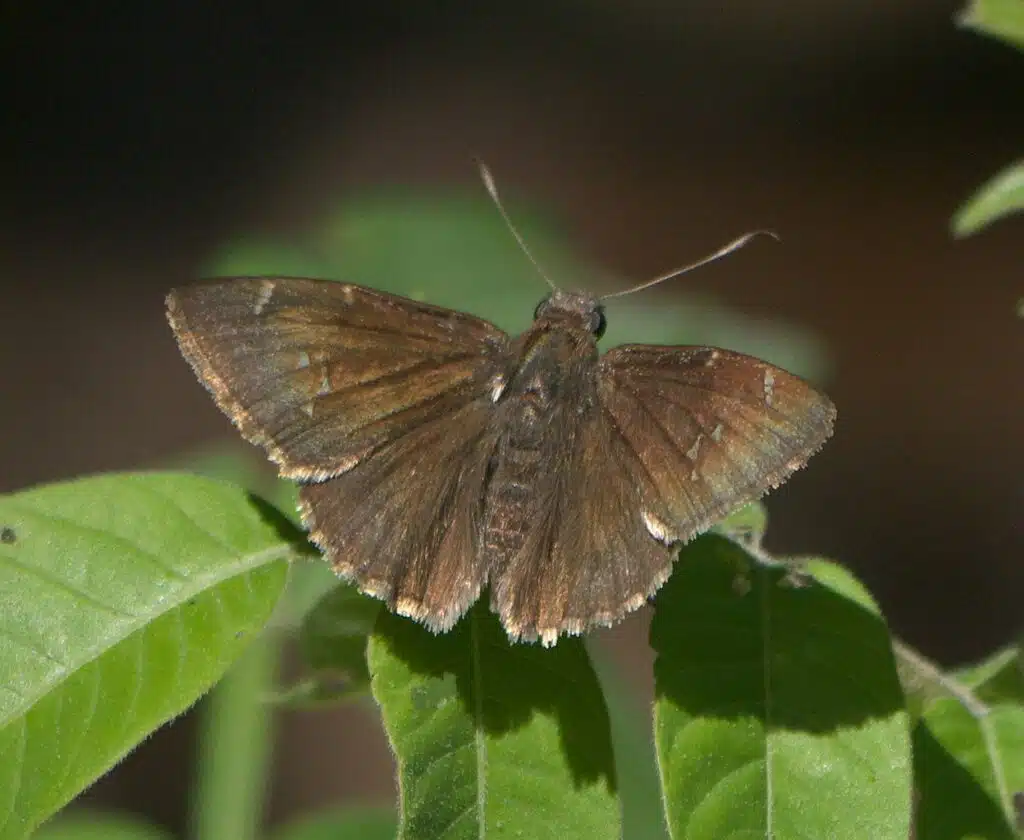
Horace’s Duskywing (Erynnis horatius) is a common species of brown butterfly across North America.
There are small differences within the species depending on its range. For example, the butterflies in the North have 1 brood less than the butterflies in Southern states such as Texas.
The male butterfly has dark brown wings with white-bordered black margins.
Females of the species have light brown, dark brown, tan, and white multicolored wings.
Butterflies of the species lay eggs directly on willows. As adults, they consume dogbane, goldenrod, and other types of plant nectar.
7. Clouded Skipper
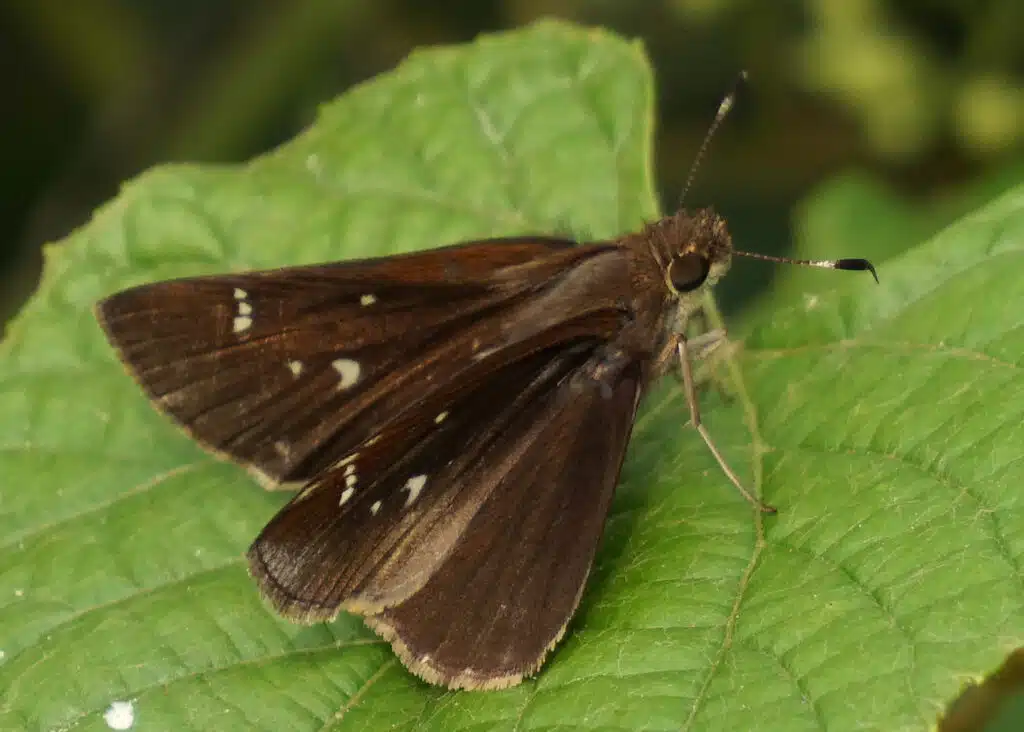
Clouded Skippers (Lerema accius) are native to Southeastern US states, Mexico, Guatemala, and Nicaragua.
This species has a short wingspan of just over 1 inch. It’s one of the species that has dark brown and light brown coloring.
You can find these brown butterflies at the edges of forests, which might explain their dark color. Furthermore, these butterflies prefer to lay eggs in the tall grass next to woodlands.
Adult Clouded Skippers have a varied diet based on plant nectar.
They are attracted to colorful flowers. You may see them during the day feeding on white and red flowers around woodlands or in open areas of woodlands.
8. Question Mark
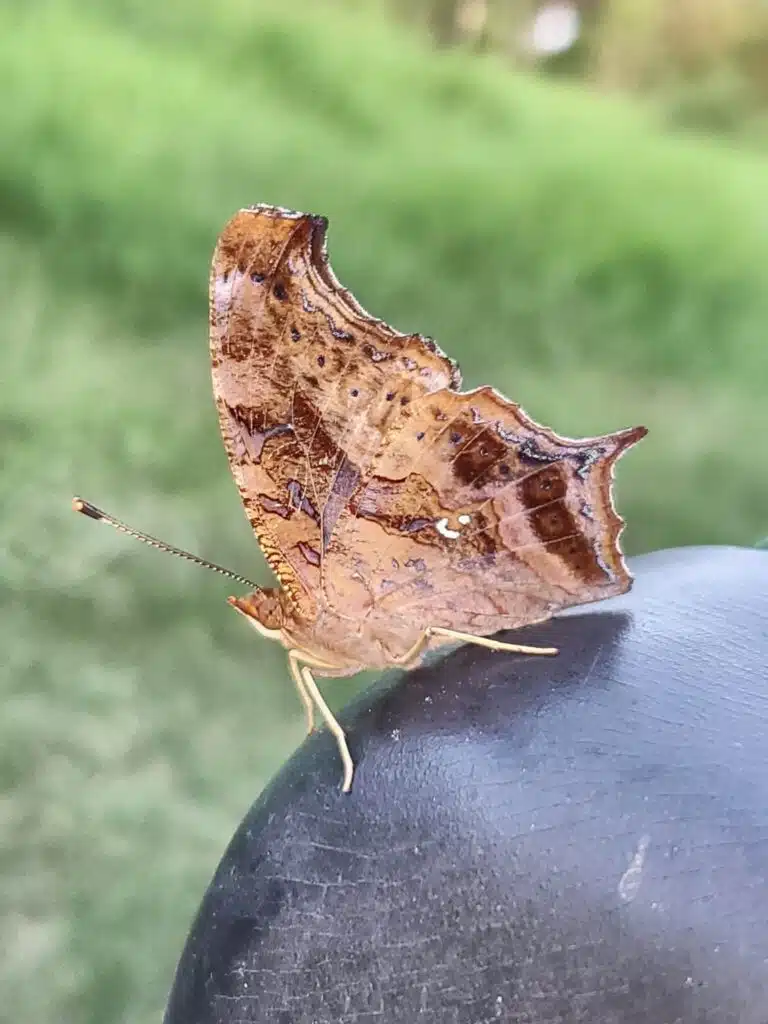
Question Mark butterflies (Polygonia interrogationis) use brown coloring for camouflage.
This is the most common brown camouflage butterfly in the US. Question Mark butterflies are mainly red dorsally.
However, they have dark brown coloring with visible lighter brown veins which make them appear like dead leaves from below.
This tactic is employed by the butterfly that sits upside down in its natural environment for camouflage.
Question Mark butterflies are also known for suddenly turning upside down whenever they face an immediate threat such as small birds.
Adult Question Marks feed on rotting fruit. They also consume plenty of dung and may feed on tree sap when hiding on trees.
9. Gray Buckeye
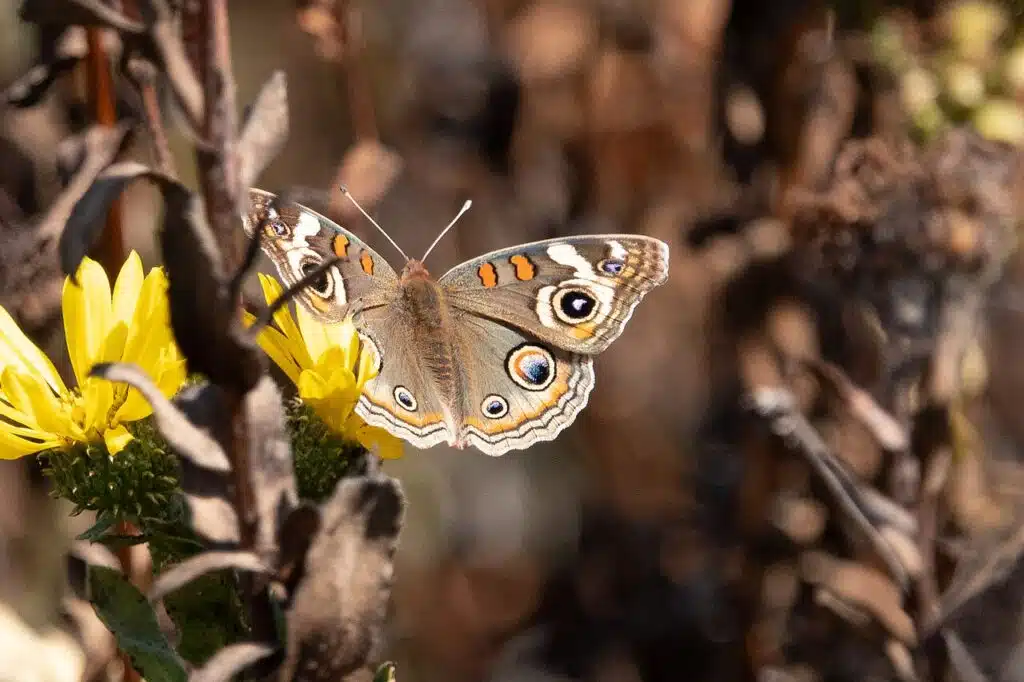
Gray Buckeye butterflies (Junonia grisea) resemble the Common Buckeye. This species is mostly seen in Western US territories, however.
The butterfly has dark brown and light brown coloring. Dark brown is specific to the upper wings while light brown is seen on the lower wings of this species.
Multiple black, orange, and white eyespots are also seen on each wing of the species.
Orange bands decorate the upper section of the wings while the margins are double black margins with continuous narrow lines along the wings.
You can find Gray Buckeye butterflies at various altitudes, mainly West of The Rocky Mountains.
10. Tawny Emperor
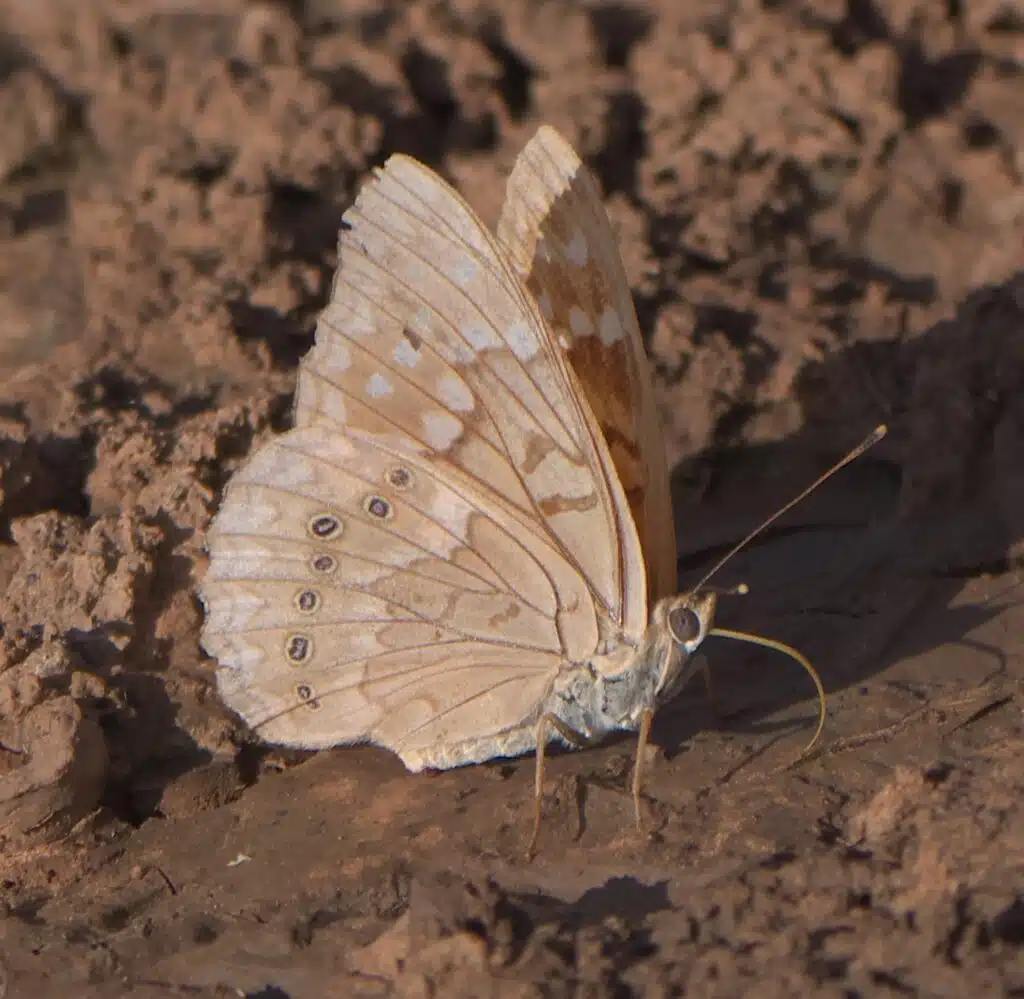
Tawny Emperors (Asterocampa clyton) are a common US species of butterflies that rely on brown ventral wings for camouflage.
This species has dark red to brown dorsal coloring with yellow spots.
Its ventral color is mostly brown and dark brown with some black marks to make it look similar to a leaf.
The species is medium to large in the US world of brown butterflies as it can have a wingspan of up to 66mm.
Tawny Emperors aren’t known for feeding on plant or flower sap as they prefer rotting fruit and dung.
You can see the butterflies in gardens and woodlands but also on farms.
11. Little Wood Satyr
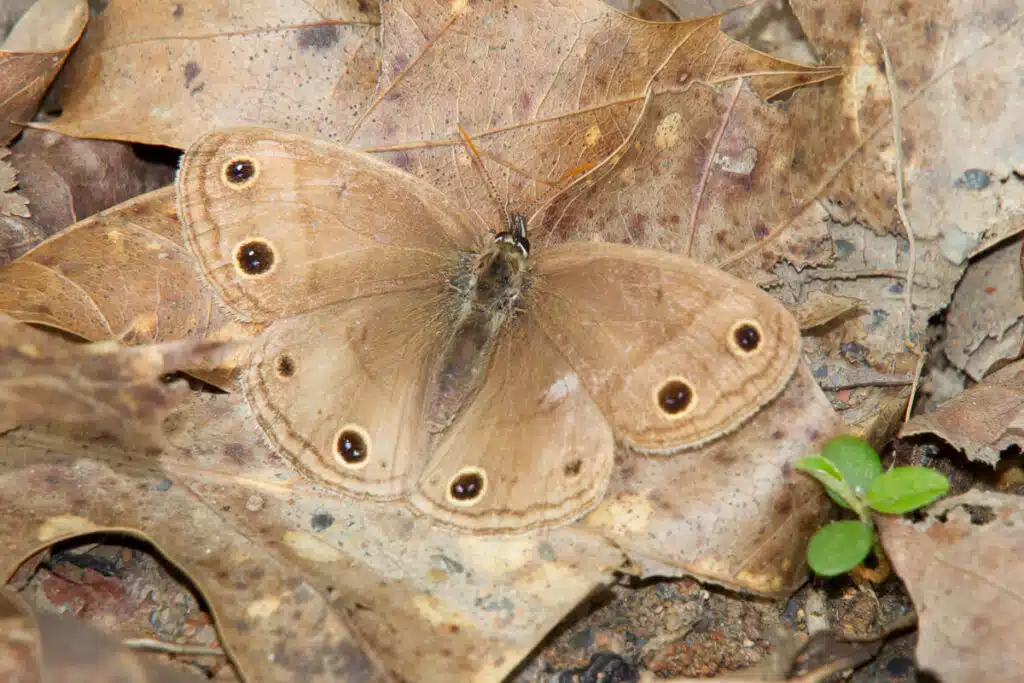
Little Wood Satyrs (Megisto cymela) are a common sight across Eastern US habitats as the species flies slowly.
It has a specific up and down flight which means this species never flies in a straight direction.
Little Wood Satyrs have multiple shades of brown that make up their multicolored wings.
Light brown and dark brown sections are separated by brown bands.
Black or dark brown eyespots are also distinguished on each wing of the species.
The Little Wood Satyr is one of the larger brown butterflies in Eastern US states. Its wingspan can vary considerably depending on lifespan and food availability.
The Little Wood Satyr butterfly can have a wingspan as short as 29mm. It can also have a long wingspan of up to 48mm.
12. Dun Skipper
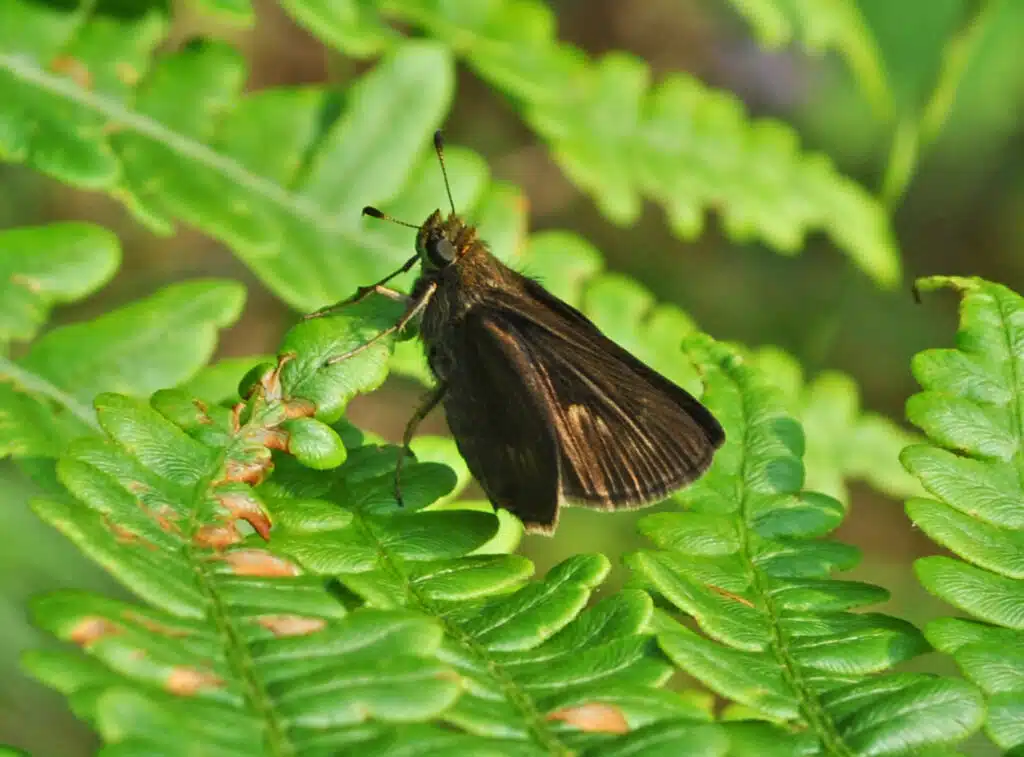
The Dun Skipper (Euphyes vestris) lives in a vast Eastern US territory around wetlands.
Butterflies of the Dun Skipper genus mostly come in a born color but they can also come in a brown and green color.
The brown-dominant male butterfly has light brown and dark brown coloring on the wings.
A few small white spots are further visible across its wings. Some of the brown colorings of the adult are similar to the brown color of the Dun Skipper caterpillar which has a brown head.
The species feeds on the nectar of multiple colorful flowers. Milkweed and purple vetch are among its favorites.
13. Northern Pearly-Eye
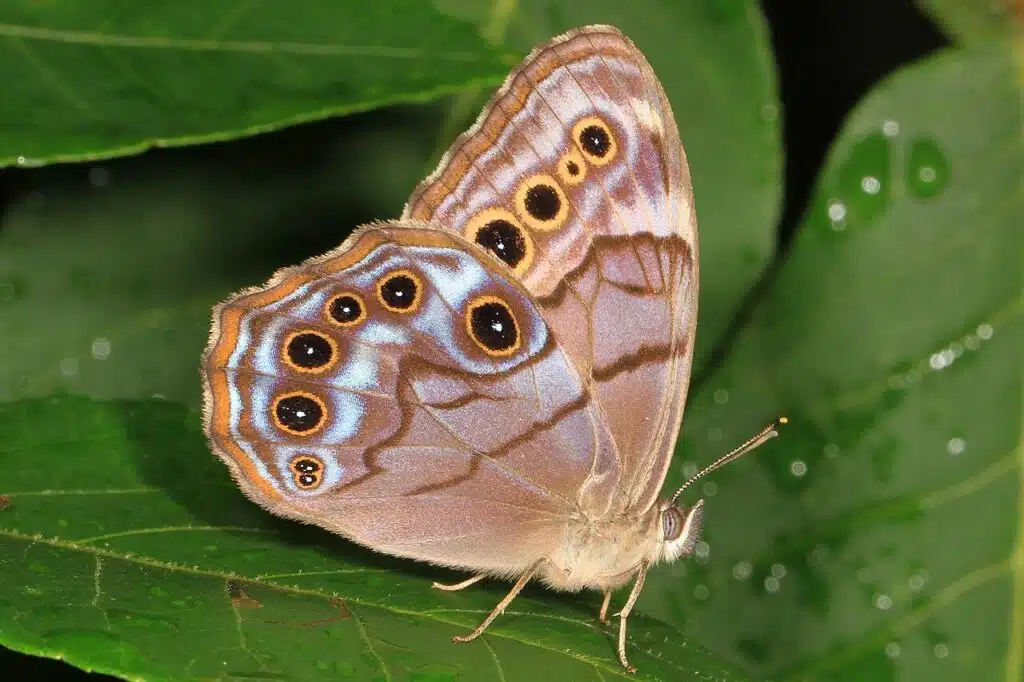
Northern Pearly-Eyes (Lethe anthedon) get their names from the northern states they inhabit.
These butterflies are mostly brown, with white margins that contrast their dark-colored wings.
Light brown similar to tan is the main color of the species both on the wings and the body.
Further nuances of darker brown decorate its wings.
Dark brown eyespots are visible across its margins while the top section of its head also has dark brown coloring.
Light brown vein-like stripes are also visible on the wings of this species.
Further dark brown marks are seen on the wings of this species.
14. Umber Skipper
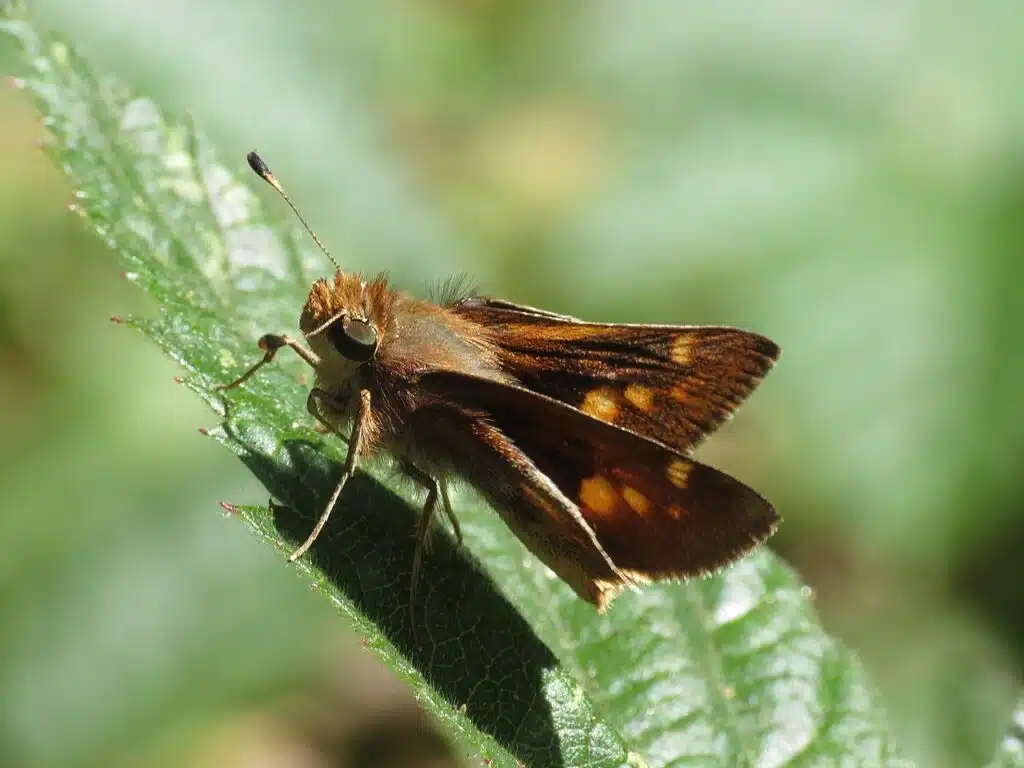
Umber Skippers (Lon melane) are most common in California and alpine parts of Mexico. This species is also reported in Arizona with an average wingspan of 30mm.
Brown, black, and yellow coloring is specific to the Umber Skipper.
Butterflies of this genus have a dark brown to black body. Brown wide wing margins are seen both on the male and the female Umber Skipper.
These butterflies further show yellow coloring in different patterns.
The yellow sections of the wings are always close to the body while the head of the butterfly has brown coloring with brown and yellow antennae.
15. Juvenal’s Duskywing
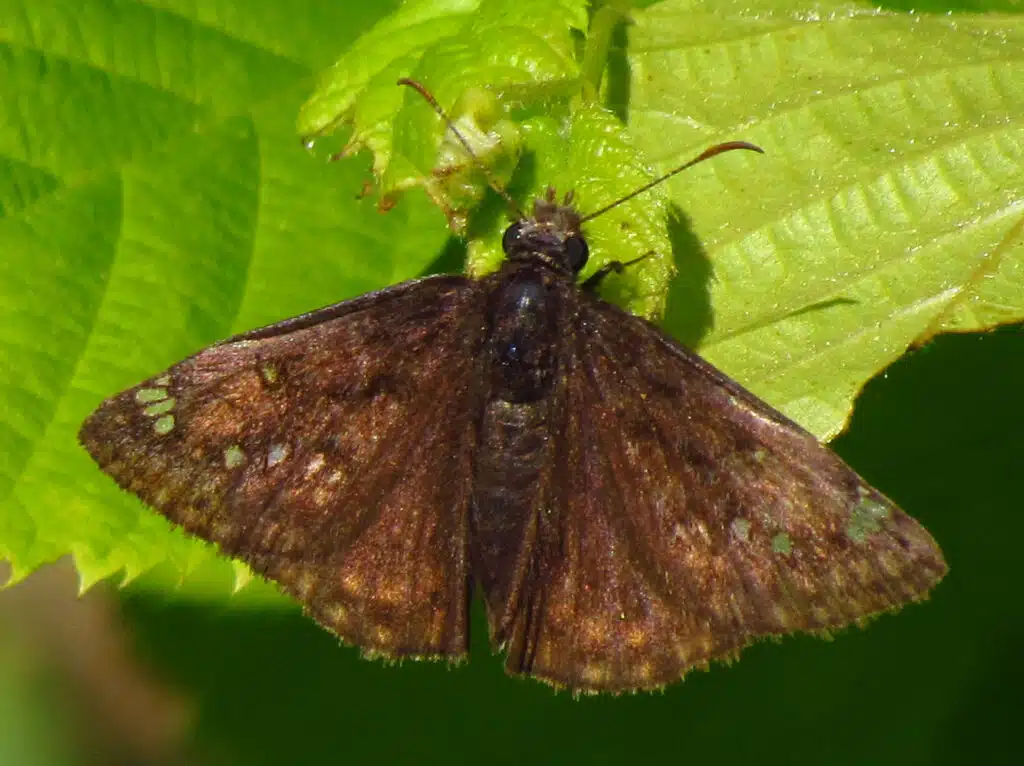
Juvenal’s Duskywing (Erynnis juvenalis) is one of the larger duskywings in the US. Its wingspan can measure up to 37mm.
Differentiating the male from the female Juvenal’s Duskywing is not easy since both have similar coloring and similar bright spots on the wings.
This species is known for having dark brown wings and a dark brown-black body. Its head is also black.
This species has dark brown veins and dark brown margins. Its antennae are a combination of alternating bright and dark brown bands.
Bright yellow or green dots are visible on the wings of these butterflies.
The same brown and light brown colors are characteristic of the species.
Small differences between the ventral of the male and the female are also visible. The female has darker patterns and dots across the wings.
16. Wild Indigo Duskywing
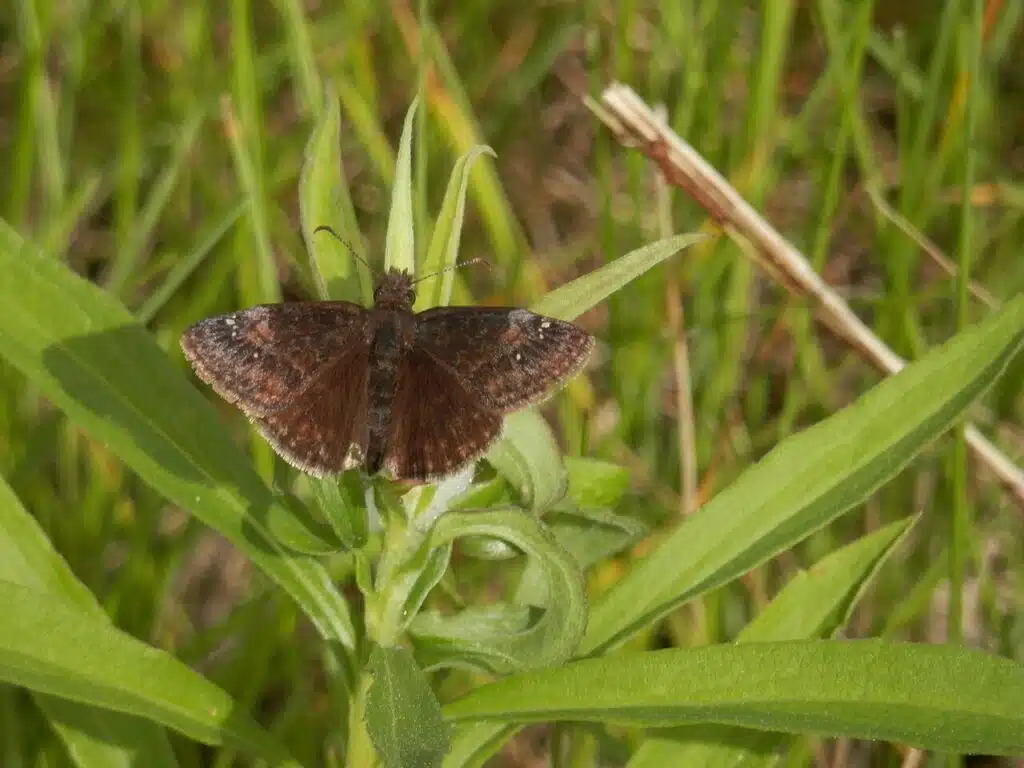
Wild Indigo Duskwywing butterflies (Erynnis baptisiae) are mostly found in the Eastern and Southeastern parts of the US.
These brown butterflies are specific to open woodlands where they take the color of various dead leaves.
Brown, dark brown, and black are among the main colors of the Wild Indigo Duskywing.
With a wingspan of up to 1.5 inches, the Wild Indigo Duskywing is dark brown on the central portion of the wings and the body.
Lighter brown is specific to the outer wings which are further decorated with either tan or light brown marks. which are further decorated with either tan or light brown marks.
The female of the species has lighter nuances of the same brown and brown color variations.
2 broods of the Wild Indigo Duskywing are seen from spring to late summer.
17. Goatweed Leafwing
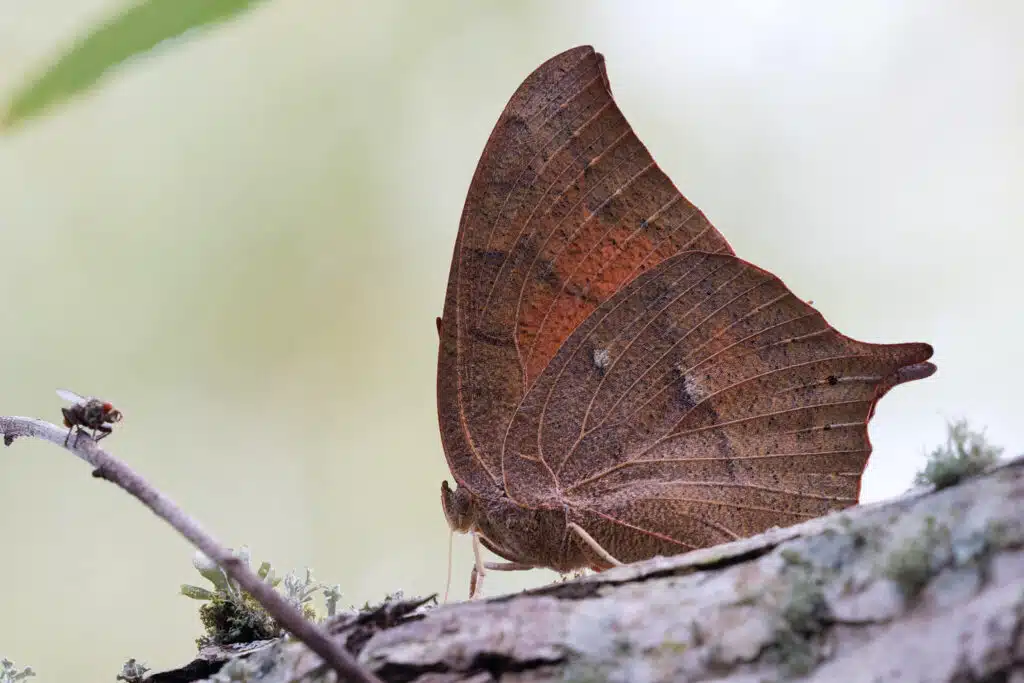
Also found in the Eastern parts of the US as the Wild Indigo Duskywing, the Goatweed Leafwing (Anaea andria) is one of the most common species of brown butterflies that mimic leaves.
These butterflies are known for their bright brick-red to brown dorsal coloring. Males have a few more patterns on the dorsal wings compared to females.
Goatweed Leafwing female butterflies have fewer patterns on the dorsum.
Both the male and the female have similar coloring of the underwings where brown is dominating.
Light brown veins that mimic leaf veins are also vividly visible on the underside of this species.
Its closed wings make the Goatweed Leafwing resemble dead leaves when it sits on ground-level leaves and helps it avoid predation.
18. Empress Leilia
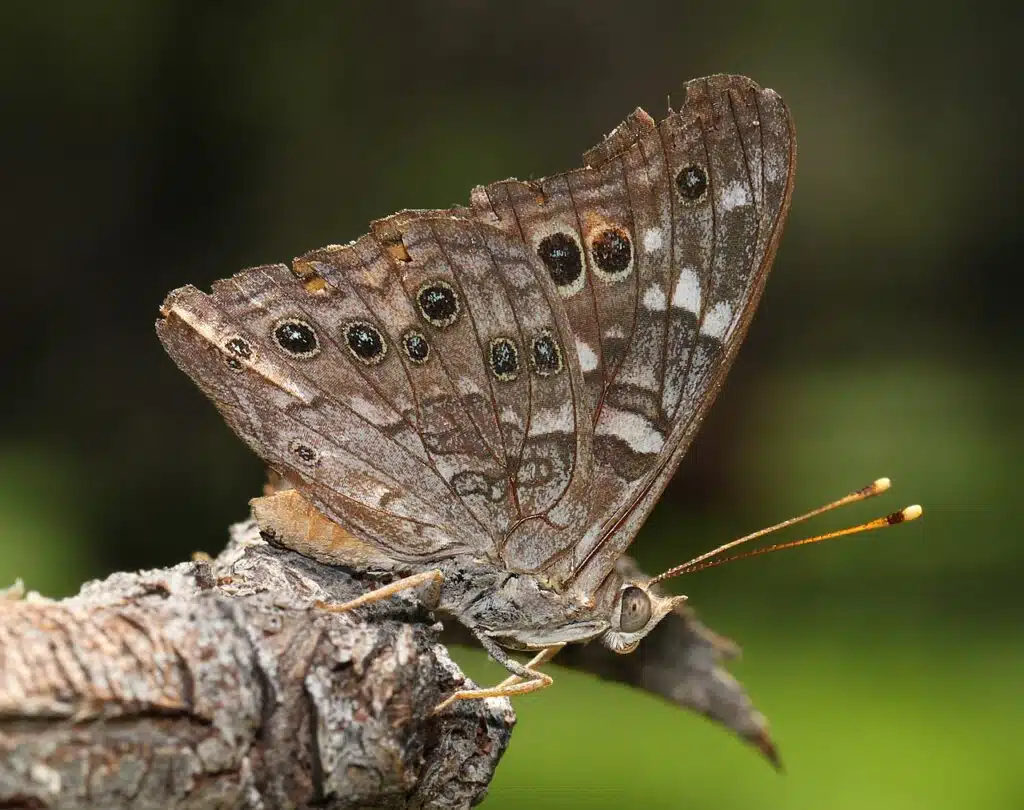
Empress Leilia (Asterocampa leilia) is among the brown butterflies that eat dung and rotten fruit. The species doesn’t consume flower nectar like other brown butterflies.
These butterflies have a brown-dominating coloring but they also have yellow and orange pattern nuances as well as white dots on the upper wings.
The central part of the wings and the body is lighter and not darker as in most other brown butterflies.
Yellow towards the body and dark brown towards the outer wings, Empress Leilia butterflies also have dark brown eyespots along the margins of the wings.
These butterflies exhibit short white lines across the margins of the wings. Alternating dark brown and yellow bands are further seen on the antennae of Empress Leilia butterflies.
19. Brown Elfin
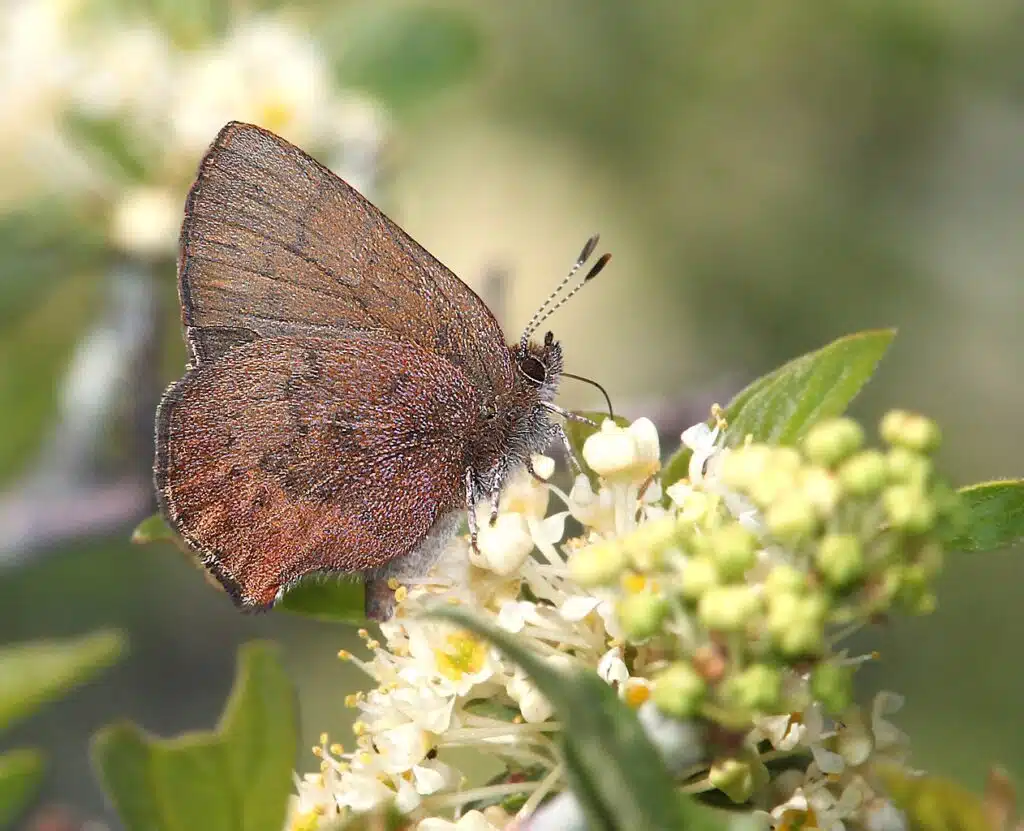
Seen around various prairies in the US up to Alaska, Brown Elfin butterflies (Callophrys augustinus) are also known for their brown color that improves camouflage.
This species lives and feeds on arbutus and another prairie genus of flowers.
Brown Elfins are known for having very dark brown underwings which makes them appear black in certain dark brown environments.
Lighter brown coloring is specific to the outer wings while dark brown coloring and black patterns are seen on the inner part of the wings.
The only light color Brown Elfins have are seen on the antennae. The antennae have alternating dark brown and white bands.
These butterflies lay eggs on plant sand they grow into caterpillars to further overwinter as pupa, mainly in leaves on the ground.
20. Fatal Metalmark
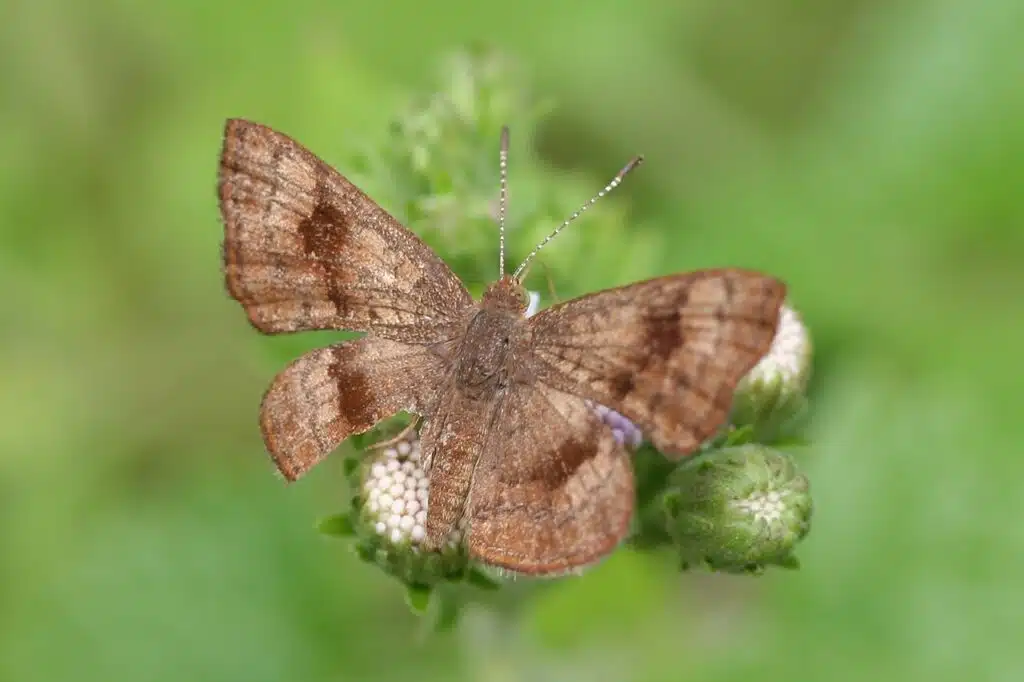
Fatal Metalmark butterflies (Calephelis nemesis) are common in Southern parts of the US with a high presence in Southwestern parts of the country as well.
It’s in California that the Fatal Metalmark faces a diminishing habitat which may hinder its population which is stable in other states such as Arizona.
Fatal Metalmarks are light brown butterflies with dark brown patterns which may appear black in some regions.
Butterflies of the genus have uniform brown coloring from the body to the margins of the wings.
Similar to other US native brown butterflies, Fatal Metalmark butterflies also have dark brown and white bands across the antennae with the tips of the antennae being mostly brown.
21. Eastern Pine Elfin
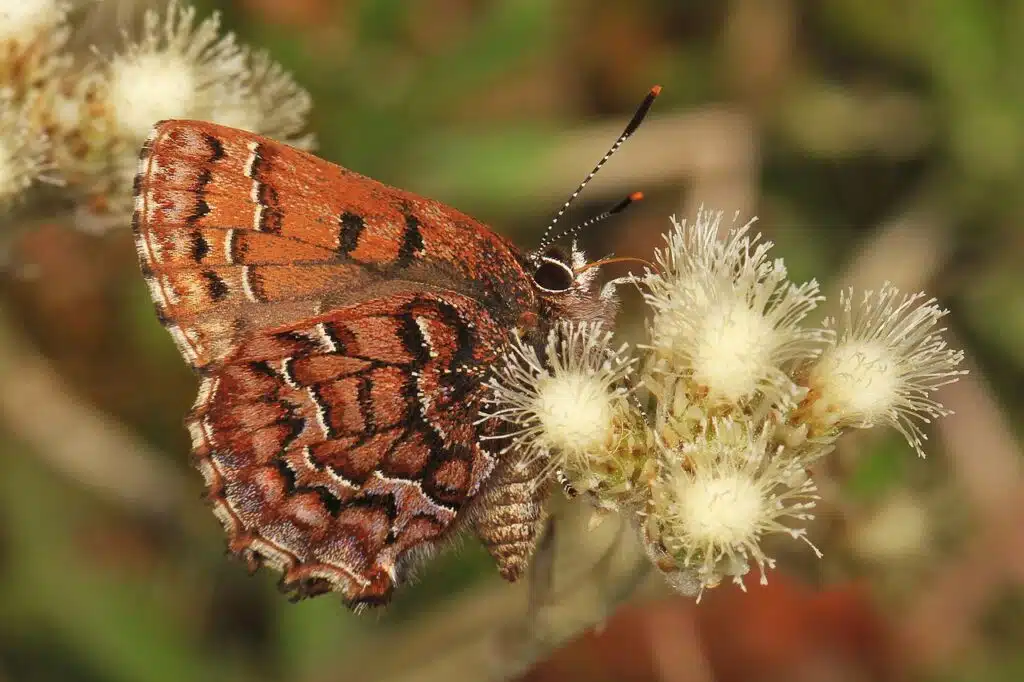
Native to both sandy areas and pine woodlands in the United States, the Eastern Pine Elfin (Callophrys niphon) is a species that measures at least 22mm.
Its wingspan can have a maximum length of up to 27.
Eastern Pine Elfin butterflies have brown wing coloring and dark brown to black lines with white borders.
These lines are vertical and they run from the central part of the wings close to the body to the outer wings.
Eastern Pine Elfin butterflies have a margin made from white, brown, and dark brown lines.
Part of a large group of colorful butterflies, Eastern Pine Elfins are categorized as native Lycaenidae.
22. Sickle-winged Skipper
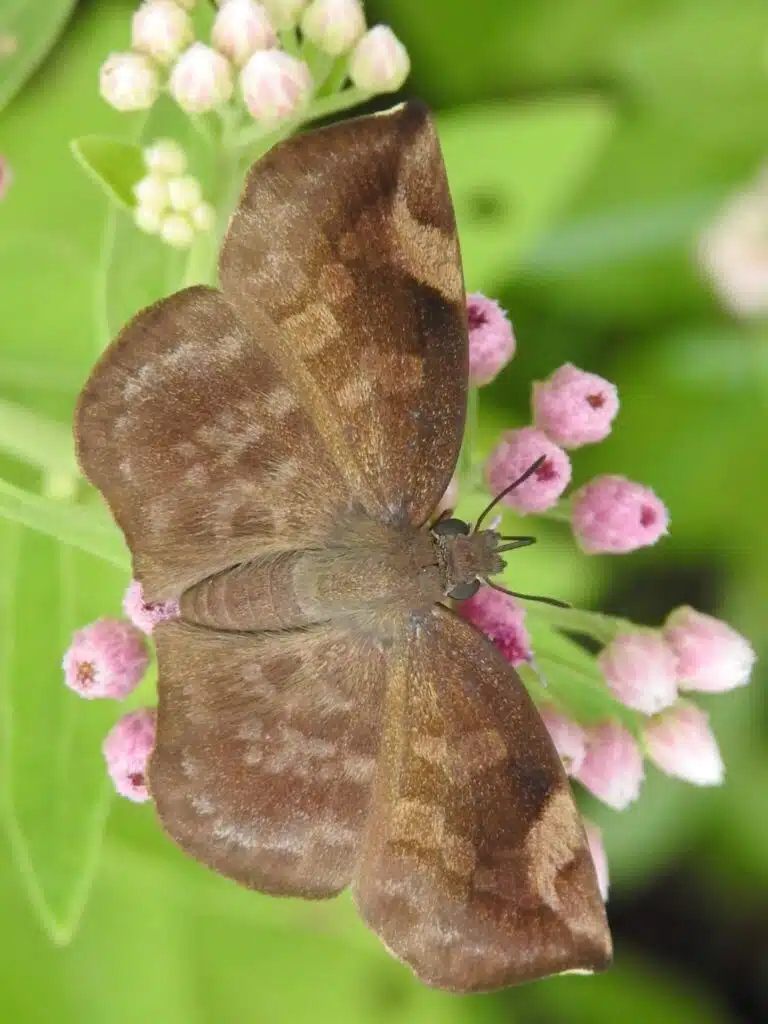
Sickle-winged Skippers (Eantis tamenund) stand out with their dark color and size compared to other brown butterflies.
This species has a large size with a wingspan of up to 45mm.
Even the smallest Sickle-winged Skipper measures at least 35mm.
Butterflies of this family have brown and black wings. Dark brown coloring is dominant for the species while bright brown is only partially seen on its wings.
Females of the species have completely different coloring, albeit still dark. Black is the dominant color of the female while purple or blue is seen as decorative color on the wings.
Both males and females have dark brown antennae.
23. Brown Longtail
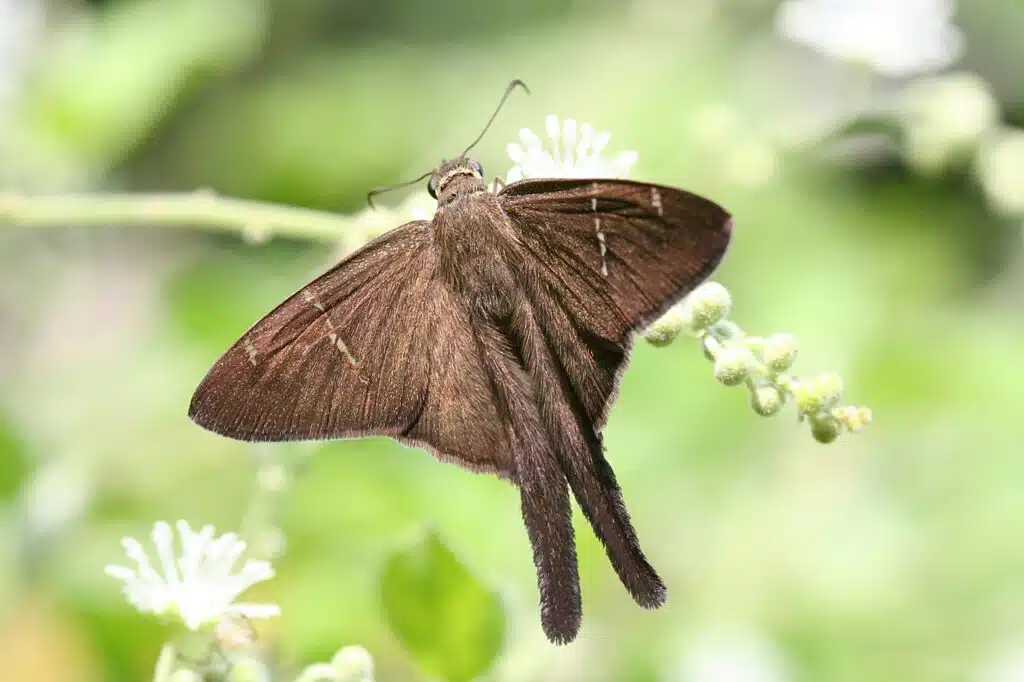
Brown Longtails (Spicauda procne) get their names from the 2 tails that characterize this species.
Apart from the long tails, the Brown Longtail also has a hairy body and hairy wings.
This species only has brown and black coloring. Brown dominates its body and its wings. Brown Longtails also have black stripes and black margins.
The lower part of the tails is also brown.
Brown Longtails are some of the largest tailed butterflies in the US. They grow to a size of up to 48mm.
Successful mating in Southern parts of the country leads to 2-3 broods per season.
24. Southern Cloudywing
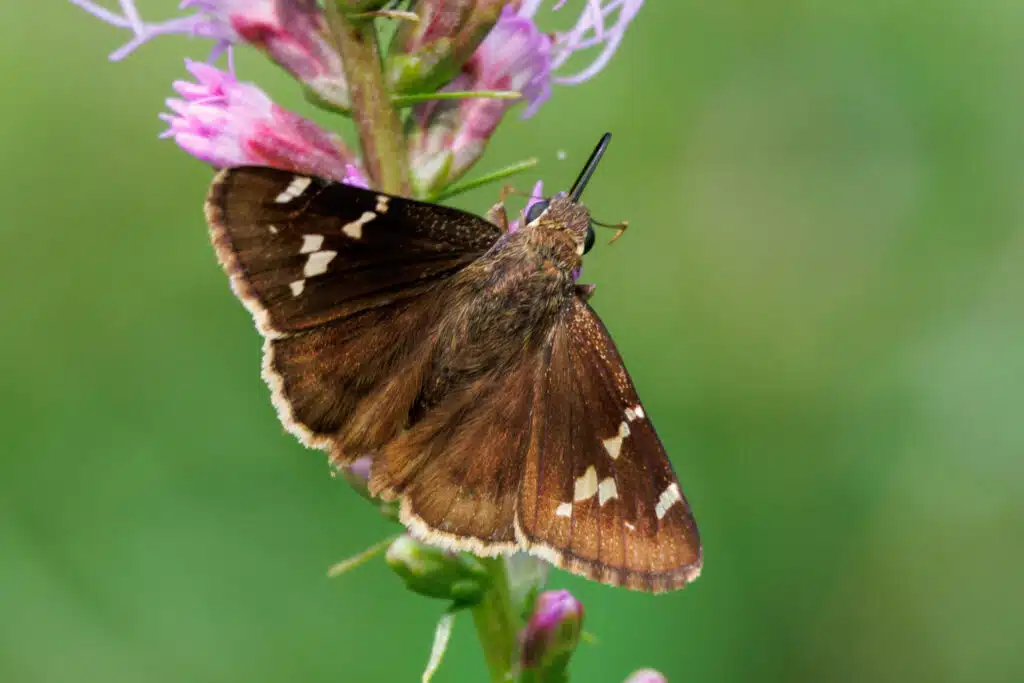
Found in dry habitats, the Southern Cloudywing (Thorybes bathyllus) is a species of butterfly with different types of brown coloring.
The species has a dark brown color on the upper wings and a light brown color on the hindwings.
Butterflies of this genus also have a few gray or silver dots both on the upper wings and on the hindwings.
Adult Southern Cloudywings feed on plant nectar. They prefer the nectar of colorful flowers.
Blue flowers are their favorite source of nectar.
These butterflies have a different diet than caterpillars. They feed on pea family plants which are also their host plants until they pupate.
25. Harvester
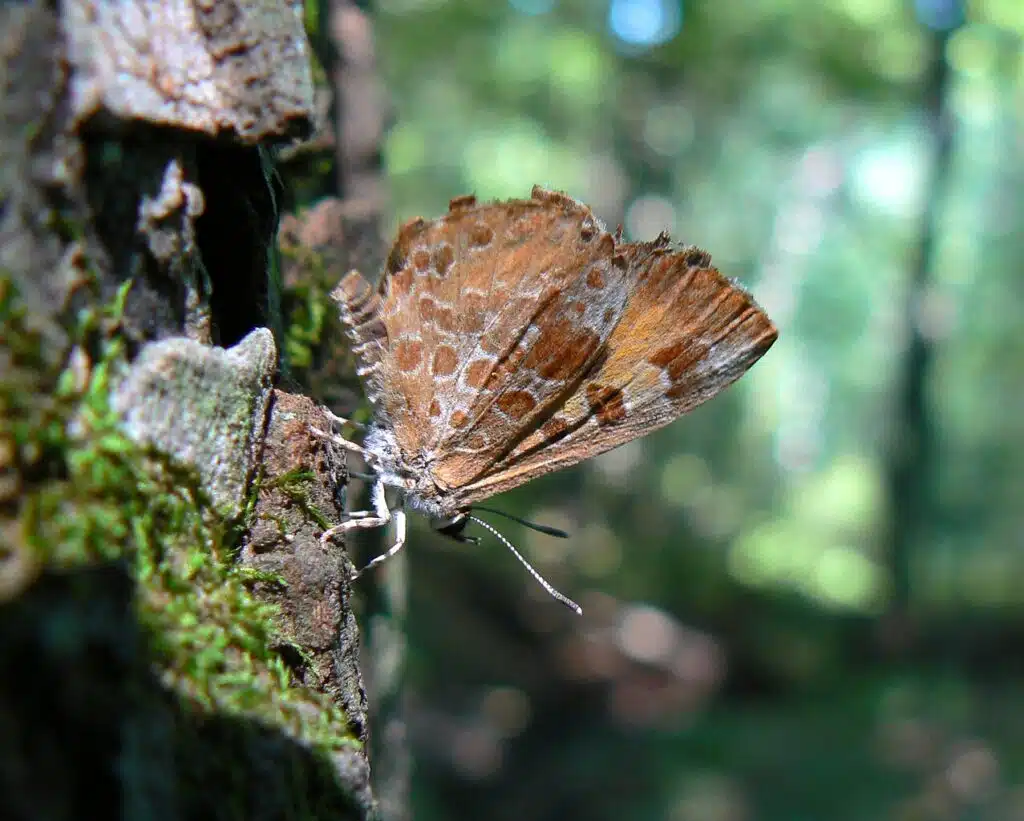
Harvester butterflies (Feniseca tarquinius) are a rare species based on their diet. Harvester butterflies are carnivores and the single recognized carnivore butterfly in the US.
This species is also brown.
Brown coloring is seen on the margins of the dorsal wings. Yellow-orange coloring is more specific to the inner parts of the wings.
Harvester butterflies also have different shades of brown that make up the bulk of their colored pattern on the ventral side.
Light and dark brown coloring with brown eyespots are specific to this species.
Harvester butterflies have known as carnivores. They eat bugs and insects from an early stage. Even Harvester caterpillars eat aphids.
26. Eyed Brown
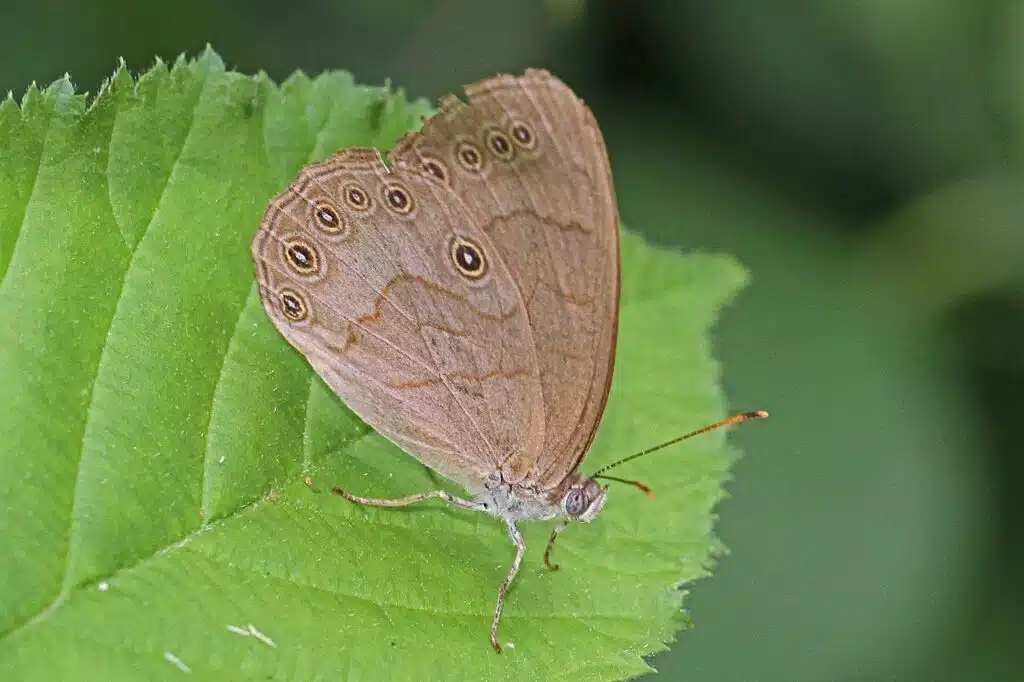
Brown and smoky brown colors are specific to the Eyed Brown butterfly (Lethe eurydice).
The most common color this species is seen in is tan-yellow with brown upper wings.
Dark brown eyespots are characteristic of the species, as its name implies.
Multiple brown spots are seen across the edges of the wings on the Eyed Brown.
These species further exhibit brown and yellow antennae with brown antennae tips.
Unlike many other butterflies with eyespots, the eyed Brown also exhibits brown eyespots on the ventral side of the wings.
Unlike the eyespots on the dorsal side, those on the ventral side have a white central point.
Eyed Brown are among the largest native brown butterflies in the US. The species has a wingspan between 38 and 48mm.
27. Southern Pearly-Eye
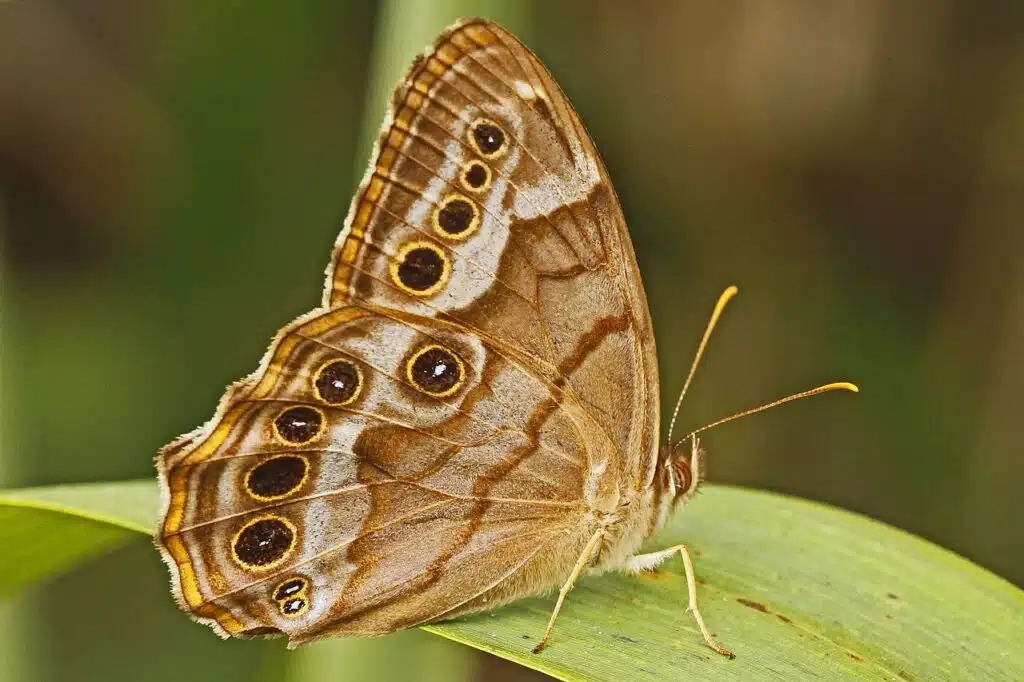
The Southern Pearly-Eye butterfly (Lethe portlandia) is known for its long wingspan that can measure up to 70mm.
Brown butterflies of this group have larger black eyespots with brown margins.
They live in the Southern parts of the country. These butterflies feed on various types of Southern bamboo as caterpillars.
Adults have a varied diet with rotting fruit and dung being their favorites.
Carrion is also a considerable food source for the adult Southern Pearly-Eye butterfly that turns carnivore and omnivore from herbivore as a caterpillar.
Southern Pearly-Eye butterflies are known to be common in Southern parts but they don’t fly throughout the year.
The larvae of the species overwinter to resume their growth in the spring.
28. Striped Hairstreak
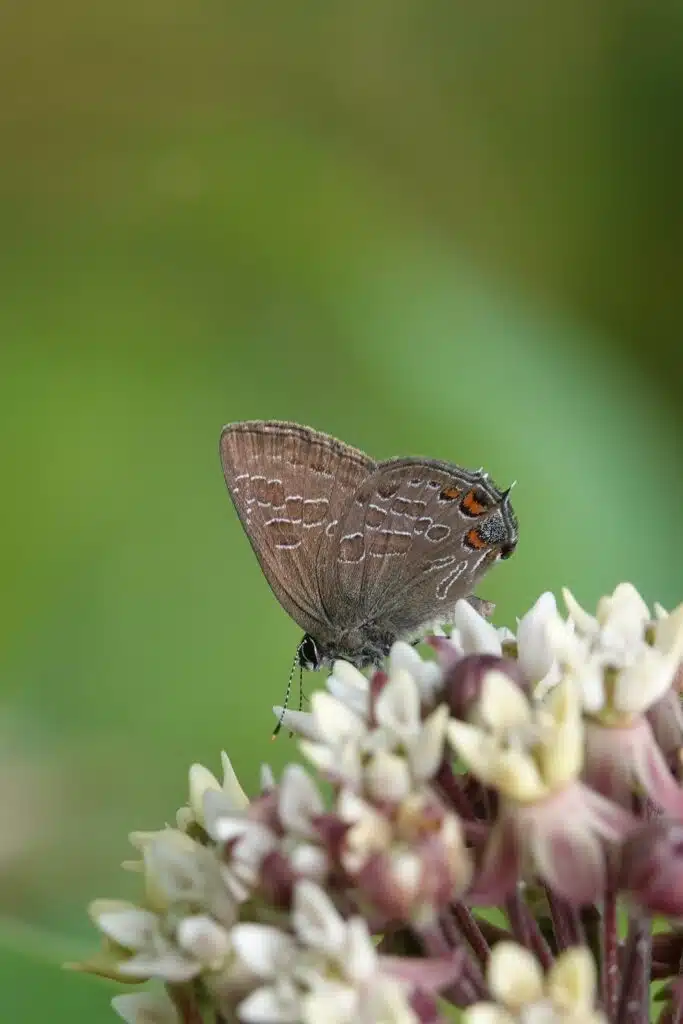
Striped Hairstreaks (Satyrium liparops) appear in different shades of brown which are different according to gender.
Males have darker brown wings with barely-visible gray lines and light brown stripes.
Females have lighter bodies with similar patterns.
The ventral side of the wings is either brown or gray with similar dark brown and white lines seen across the margins of the wings.
This species feeds on various plants that also provide nectar for other species. Dogbane and goldenrod are among their favorite foods.
Striped Hairstreak butterflies have different hosts and are a common sight and pest of roses.
29. West Indian Mangrove Buckeye
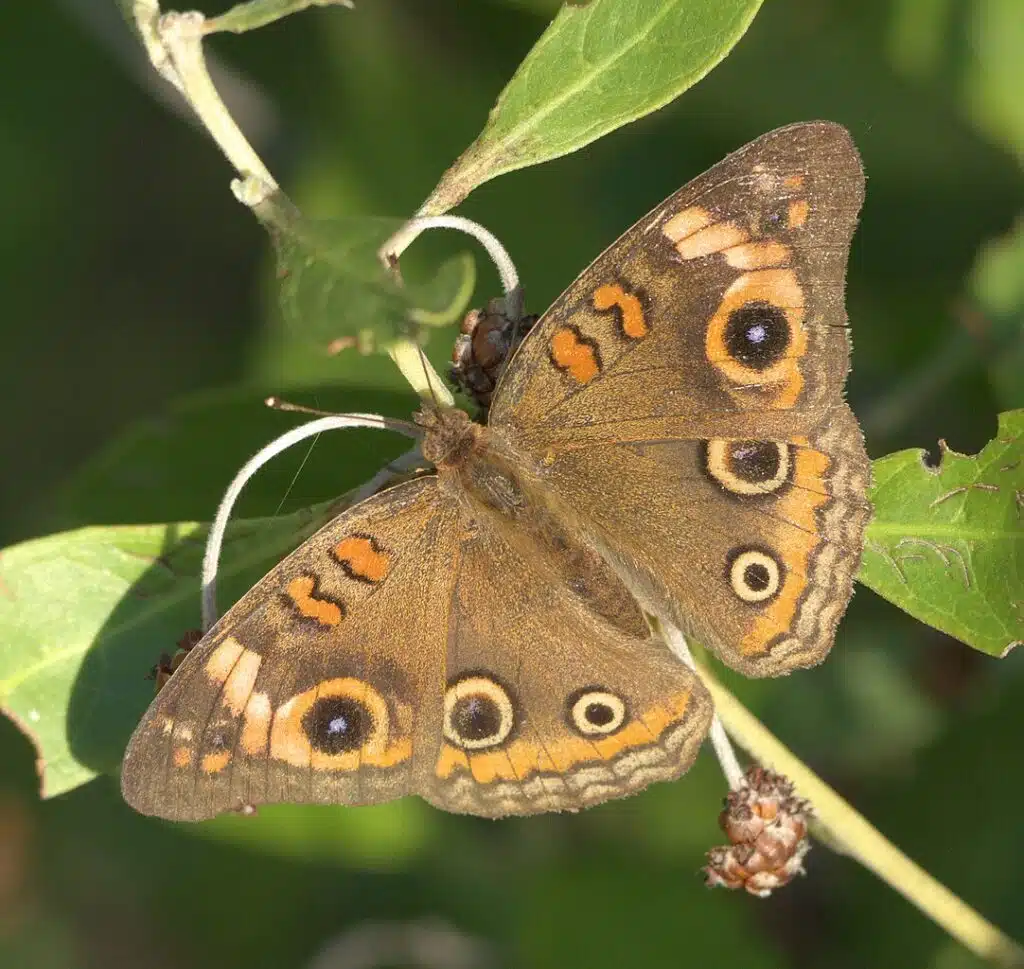
This species of butterfly (Junonia neildi) has been seen in the US for at least 2 centuries. The West Indian Mangrove Buckeye is found in Southern states.
Florida and nearby states are the regions the West Indian Mangrove Buckeye is most common.
As its name implies, this brown butterfly stands out with eyespots on its wins. Black eyespots with double white and black margins are seen across its upper wings and its hindwings.
These butterflies have a brown body and wing coloring with yellow and white patches towards the margins.
Orange marks and spots are also seen on its upper wings and towards the margins of its hindwings.
The species also has light brown antennae.
30. Rounded Metalmark
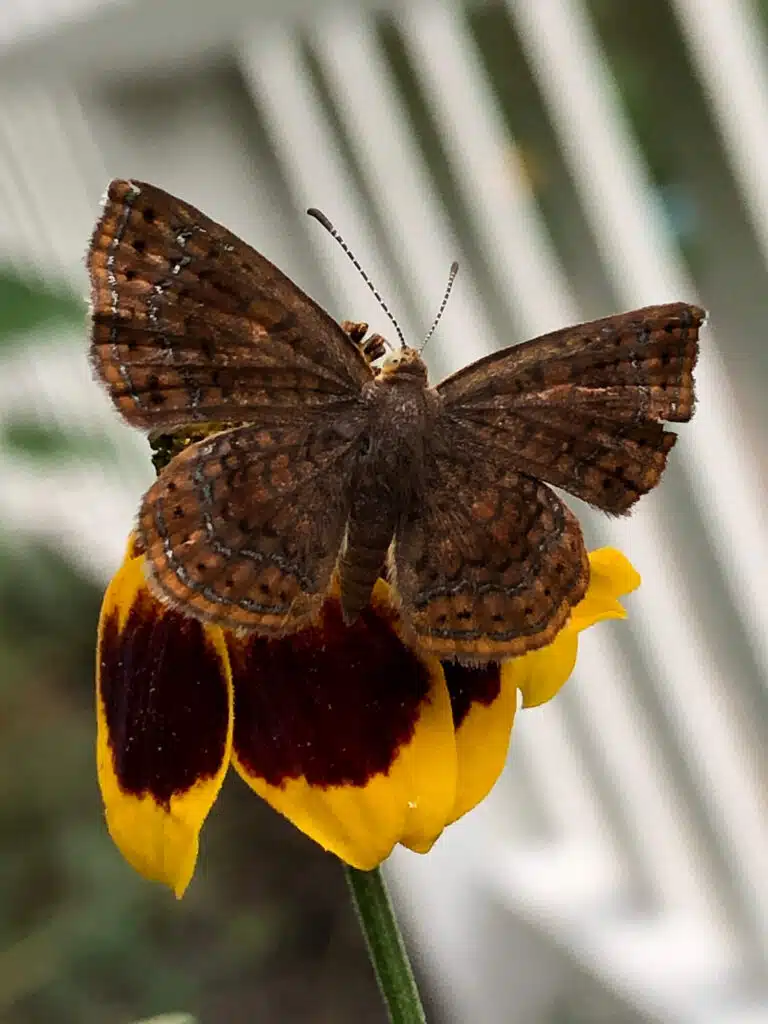
Rounded Metalmark (Calephelis perditalis) is a native species of butterfly with a short to medium wingspan.
The species has a wingspan between 18 and 24mm.
It stands out by having a high resemblance between the ventral and the dorsal sides both in color and in patterns.
Dark brown is specific to the dorsal and ventral sides of the wings.
Both sides of the butterfly have short black stripes as decoration on the wings.
Its closed wingspan makes this species look like wood, which helps it hide from its predators on logs and trees.
31. Little Metalmark
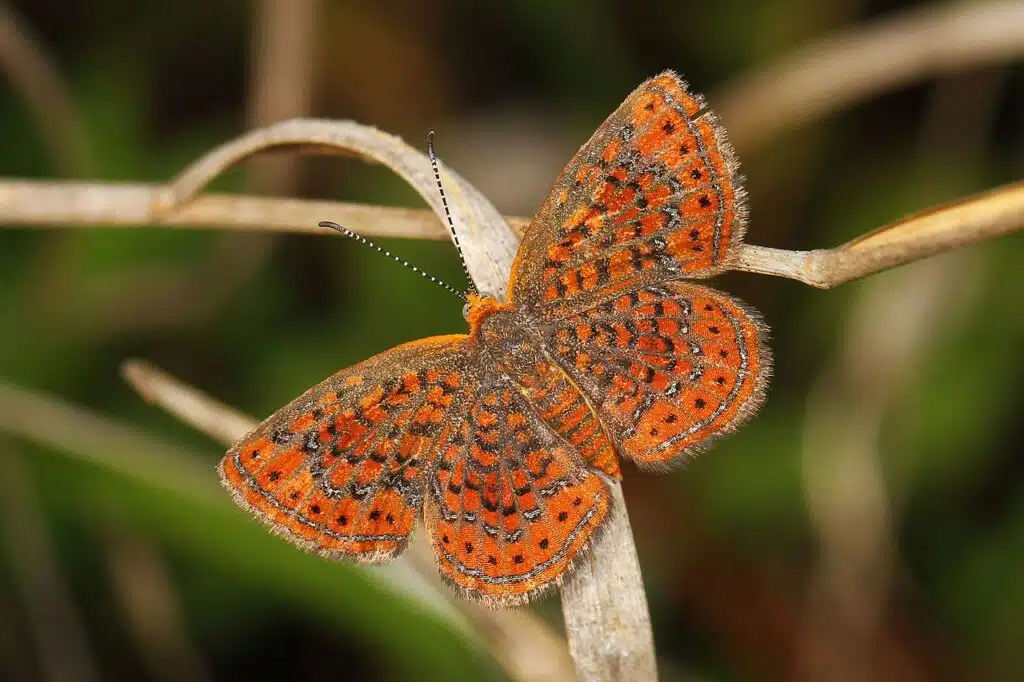
Little Metalmarks (Calephelis virginiensis) have some of the most decorated wings among the brown butterflies of North America.
Multiple black lines and stripes form a spider-like decorative web on the brown wings of this species.
The white borders of its wings contrast the otherwise dark color of the Little Metalmark.
This species bears little resemblance to the late instar Little Metalmark caterpillar.
Caterpillars in their first instars are brown and white while the late instar Little Metalmark caterpillar is green with white hairs.
32. Gorgon Copper
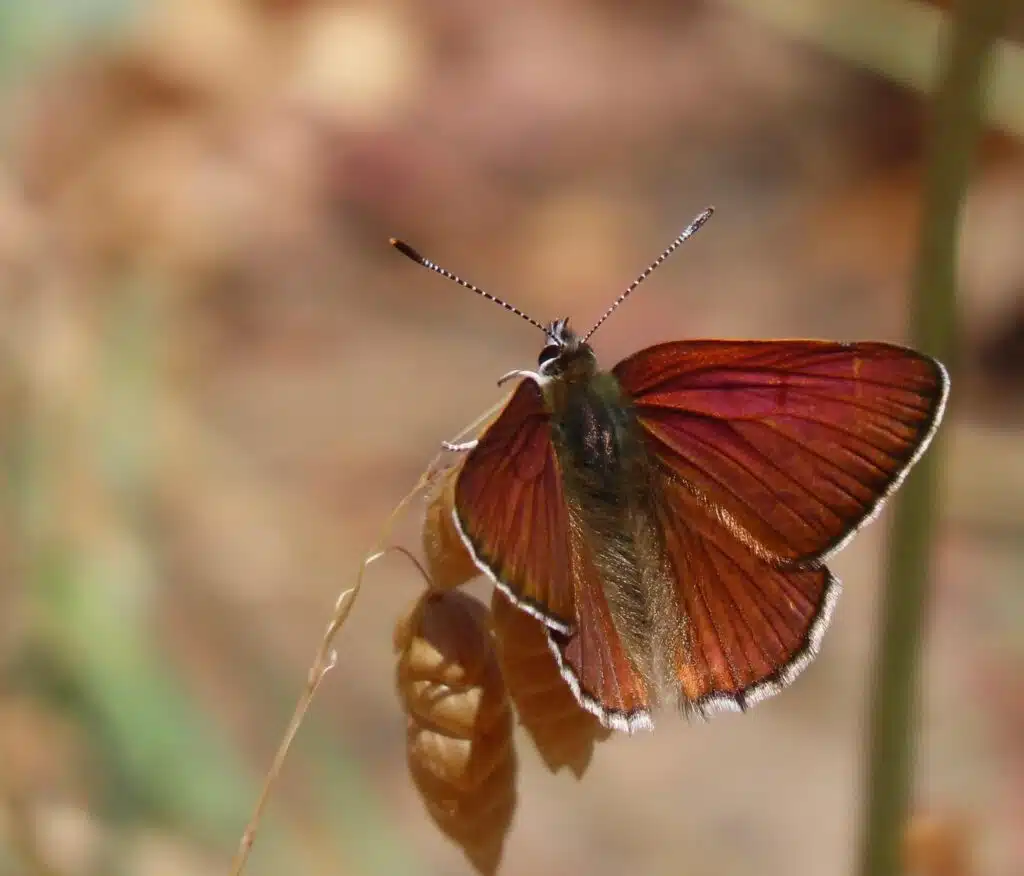
Seen on various meadows, the Gorgon Copper (Tharsalea gorgon) is a species that grows to a maximum wingspan of 1.5 inches.
This species is among those that come in various shades of brown with small differences between males and females.
Gorgon Copper can have mostly brown coloring or brown wings with black marks, depending on the gender.
Black borders are specific to both the male and the female Gorgon Copper.
The species can be found as a caterpillar on buckwheat host plants.
33. Tailed Copper
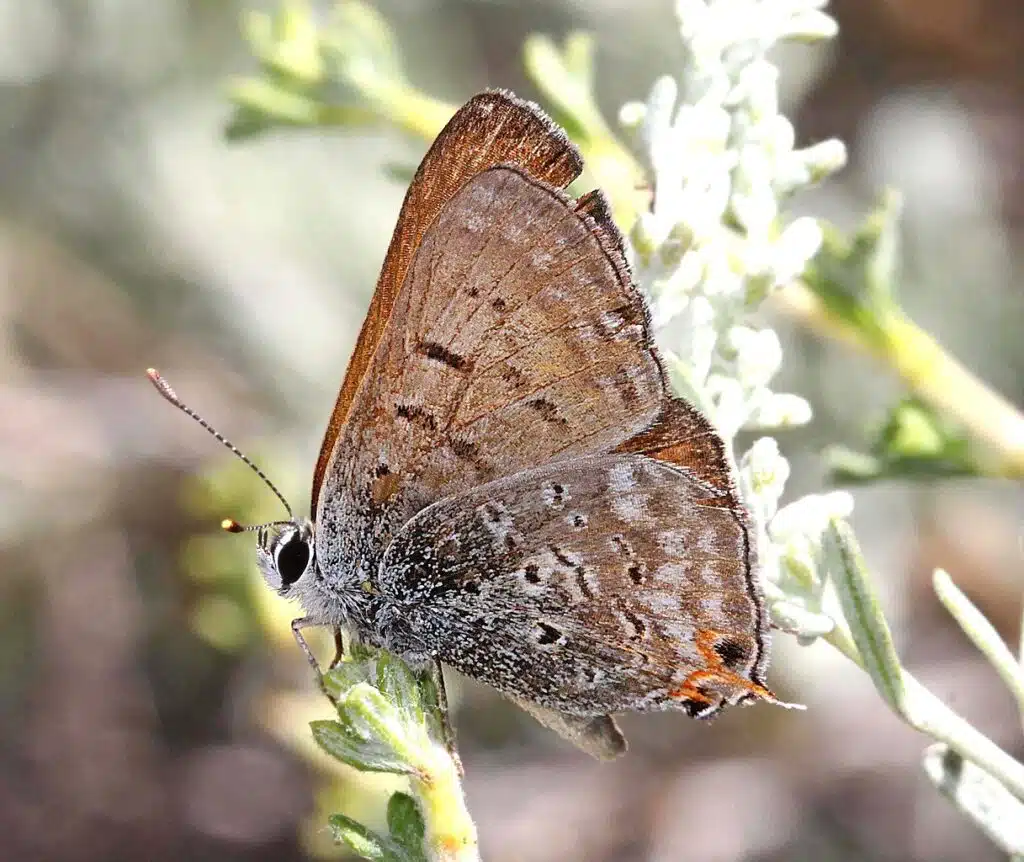
Brown and orange coloring are specific to the dorsal side of the Tailed Copper (Tharsalea arota). Brown and yellow morphs are also common in the US.
Many know this species by its gray color with black spots and orange margins, a combination of patterns specific to the ventral side of the butterfly.
Tailed Coppers are some of the most common migratory brown butterflies in the United States.
These butterflies migrate at least once per year. Multiple migrations can be possible over short distances for food.
Overwintering as eggs, Tailed Copper caterpillars are a common sight on various currant shrubs.
34. Hayhurst’s Scallopwing
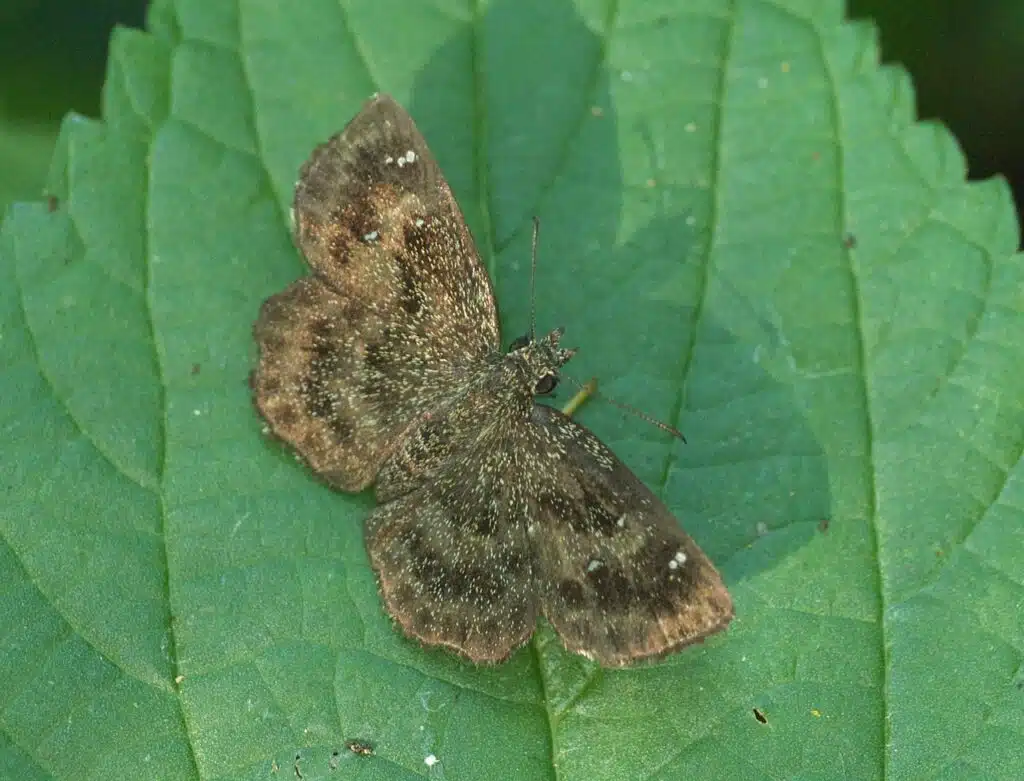
Common across most US states, this butterfly species (Staphylus hayhurstii) has the longest flight season in Florida.
It’s seen late in the season up until December in Southern Florida.
Butterflies of this genus have dark and light brown coloring. Dark brown color nuances cover almost the entire surface of its wings.
Light brown marks are seen across its wings. The margins of its wings are also light brown.
35. Crossline Skipper
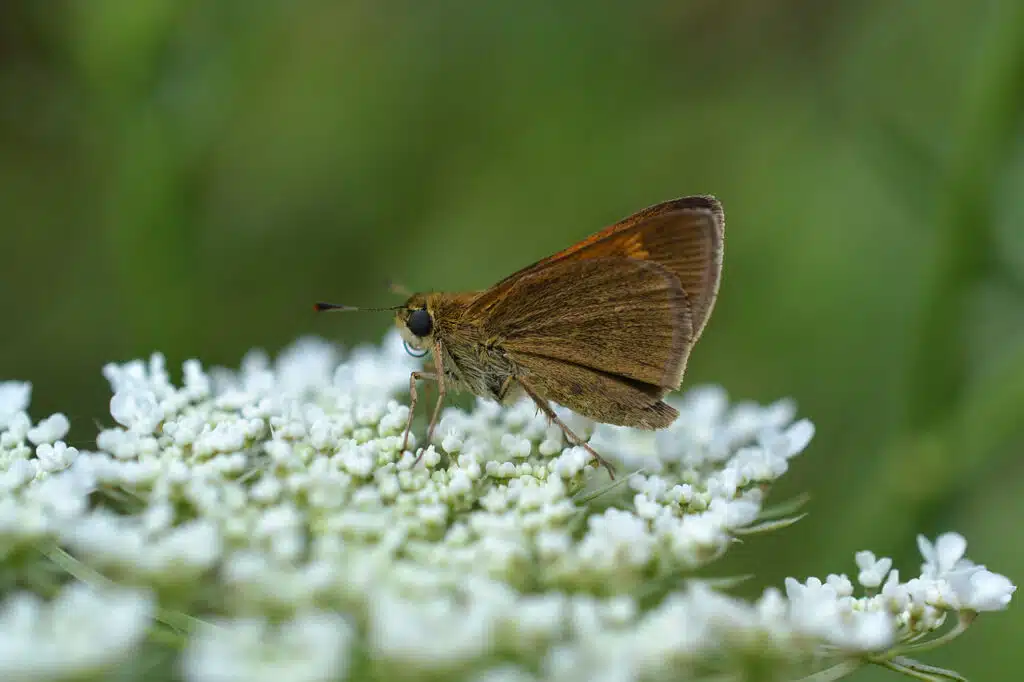
Crossline Skippers (Polites origenes) are found in most US states.
With a wingspan of up to 30mm, this species is known for its dark brown to gray base color.
This color is seen both on its body and its wings. The wings are mostly dark brown but they also show yellow spots.
Smaller yellow marks are also barely visible on the wings of the male Crossline Skipper. Females have darker brown coloring without yellow marks.
36. Common Alpine
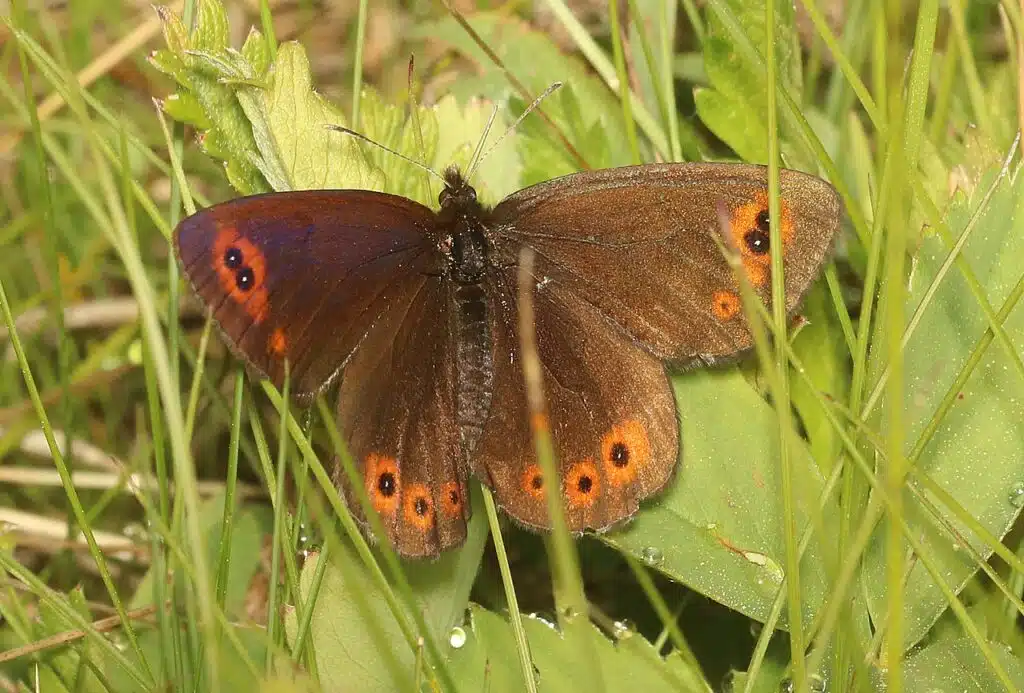
Common Alpine butterflies (Erebia epipsodea) are seen across a wide range of alpine territories from Alaska to Southern US habitats.
This species has a dark brown color that’s almost black.
Lighter brown eyespots are seen on its lower hindwings.
Common Alpines have a different flight season depending on their location. This species is one of the largest brown butterflies native to the US.
It can have a long wingspan of up to 45mm.
37. Texas Powdered Skipper
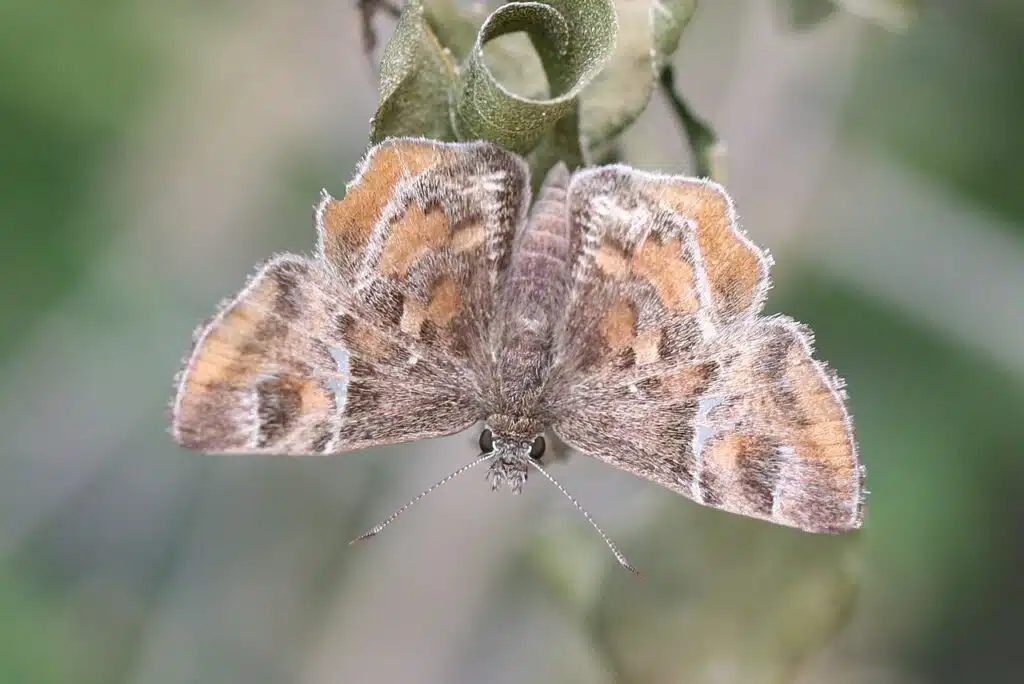
A common sight on Texas mallows, the Texas Powdered Skipper (Systasea pulverulenta) is one of the maroon species of the state.
These butterflies have brown, light brown, and black coloring. The tri-colored pattern helps this species remain undetected by predators on different plants.
Adults of the species prefer to feed on plant nectar while Texas Powdered Skipper caterpillars feed on mallows.
The species has a very long flight season in Texas. It appears in February and it remains active until the beginning of December.
38. Thicket Hairstreak
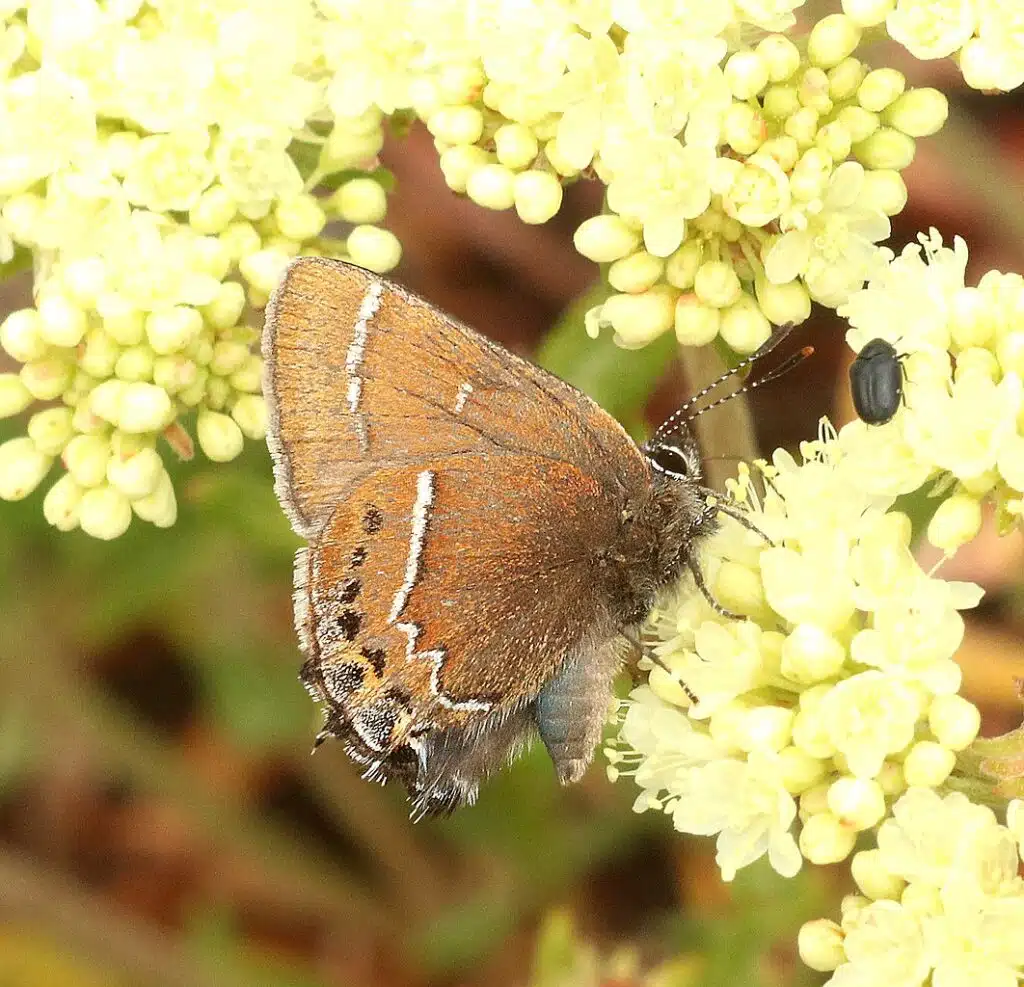
Thicket Hairstreaks (Callophrys spinetorum) have a blue dorsal color and a red-brown ventral color.
Black eyespots are visible on the margins of the wings. These butterflies also have black and white stripes across the hindwings and the upper wings.
Unlike many other similar species, the Thicket Hairstreak is seen in Western territories.
Its habitat expands from British Colombia in Canada to Baja California in Mexico.
39. Common Streaky-Skipper
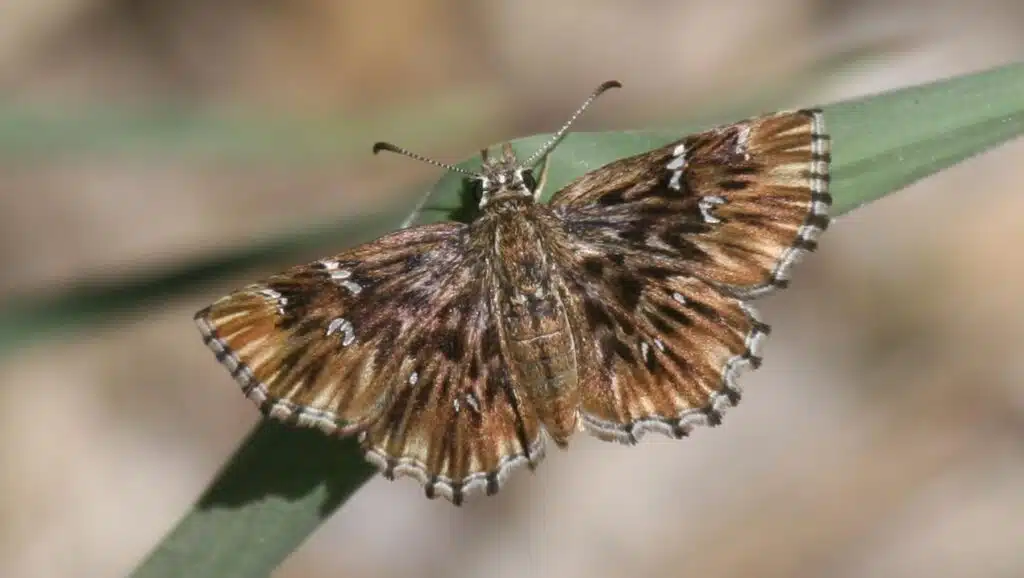
Common Streaky-Skipper butterflies (Celotes nessus) have orange-brown, dark brown, black, and white coloring.
The color of the species has often been compared to the color of native eagles.
Butterflies of the genus live in different types of Southern forests. Texas, New Mexico, and Arizona forests are the best places to find the Common Streaky-Skipper.
Mallows are the common host species of its caterpillar while adults consume flower nectar from various flowers.
40. Arizona Powdered-Skipper
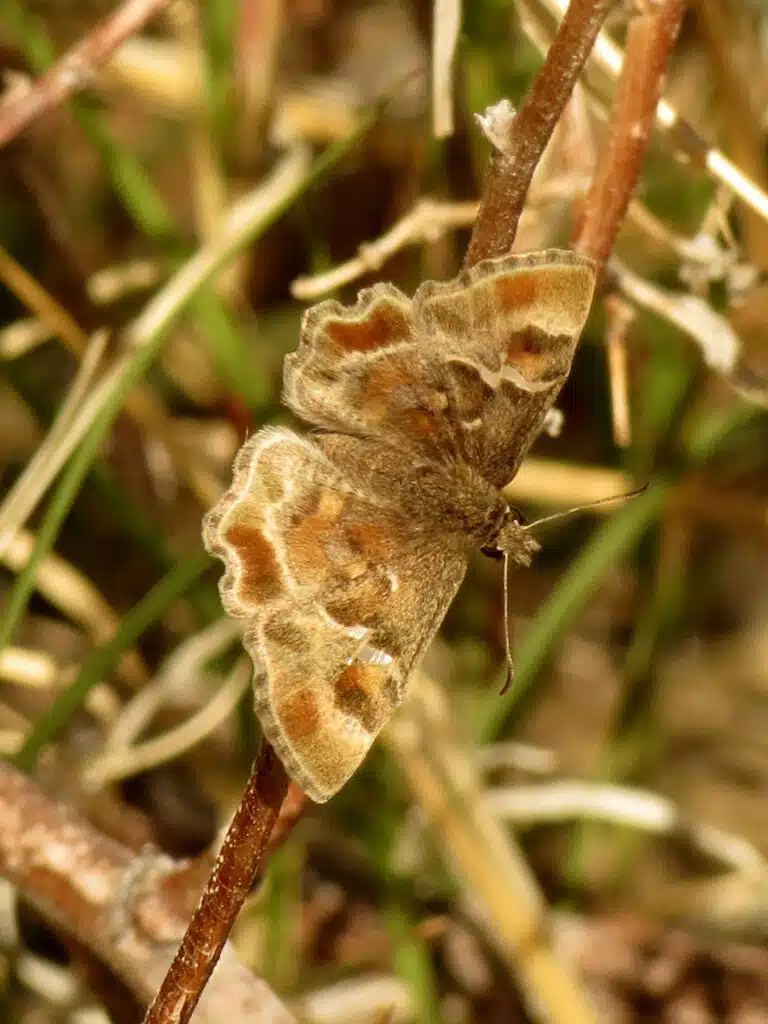
Common in deserts and canyons across Southern states, the Arizona Powdered-Skipper (Systasea zampa) gets its name from
its brow, black, and gray body with white marks.
A large section of its lower upper wings and its hindwings are covered in white patches or white lines, which make this skipper look unique.
Its light brown and gray coloring also helps it blend in with the rocky or sandy terrains it lives on most times.
You can find the caterpillar of the Arizona Powdered-Skipper on mallows adapted to arid conditions in the South.
41. Dull Firetip
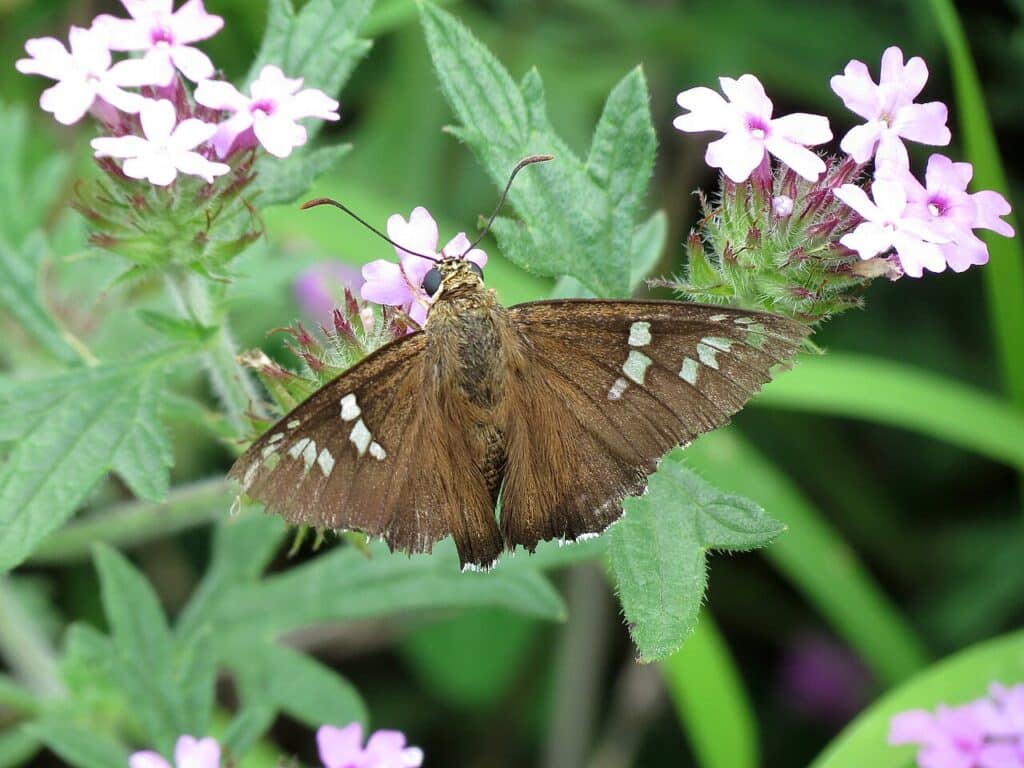
The Dull Firetip (Apyrrothrix araxes) is one of the fast-flying brown butterflies.
Native to the US, this species is known for its decorated wings even if the base color is brown.
A light brown color is specific to this butterfly. This light brown color covers the upper wings and the hindwings.
Dark brown to black coloring is specific to the outer wings or to the wing margins which may also exhibit short white lines and dots as decoration in the case of the male Dull Firetip.
This species also stands out with its hairy body and hairy brown wings.
42. Northern Metalmark
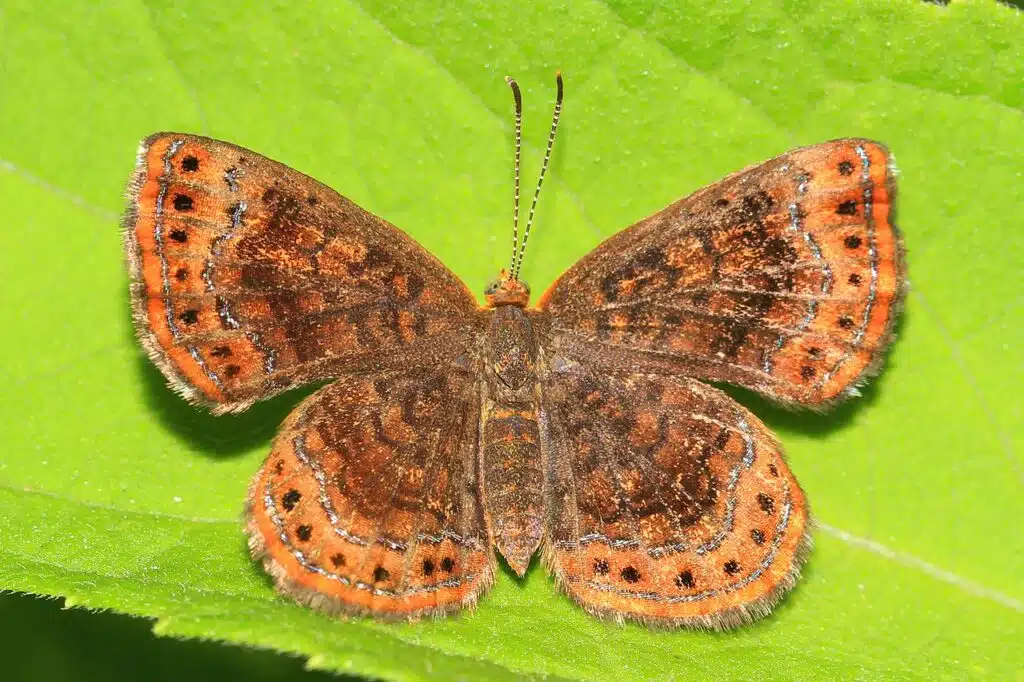
Northern Metalmark butterflies (Calephelis borealis) are among the few species that feed on both yarrow and butterfly weed.
However, these butterflies also feed on more common nectar sources such as sweet clover and goldenrod.
You can identify the species by its dark brown color and wingspan of up to 32mm.
These butterflies have dark brown upper wings and light brown hindwings.
Further black patterns are seen on its body. These are formed by short black stripes and black dots.
White marks are also visible on the outer wings of the species.
43. Band-celled Sister
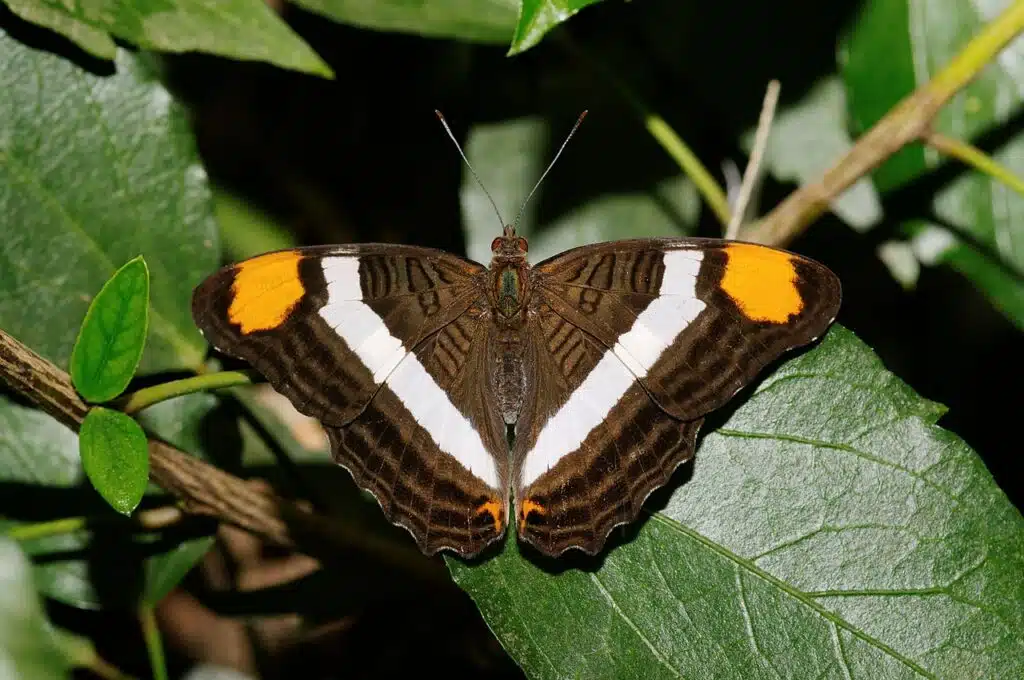
Only native to Southern Texas in the US, this species (Adelpha fessonia) is found in open forest habitats, especially those next to water sources.
This species is known for its V-shaped white bands seen on males and females.
Other color differences between the males and females are a bit more visible.
Males have lighter brown coloring with black patterns.
Females have dark brown coloring which almost makes them look black.
Light brown patches are seen on the outer edges of the upper wings and the lower part of the hindwings.
44. Twintip Buckeye
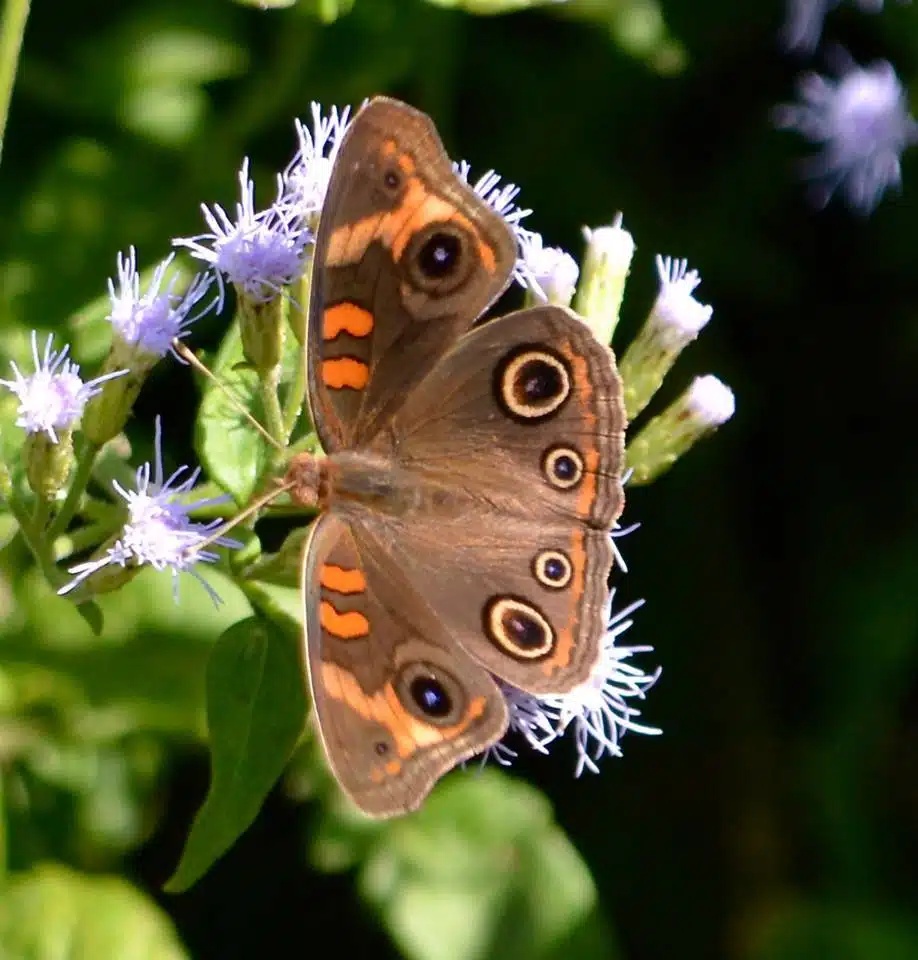
The Twintipe Buckeye butterfly (Junonia stemosa) has multiple black and brown and black and blue eyespots.
Brown is the base color of the wings. Male and female Twintip Buckeye butterflies have black eyespots. The color in the center of the eyespots differs from the hindwings to the upper wings.
Further orange-brown marks with black borders are seen on the upper wings. Each wing has 2 orange marks on the upper wings.
3 brown bands form the margins of the wings for the Twintip Buckeye.
45. Brown-banded Skipper
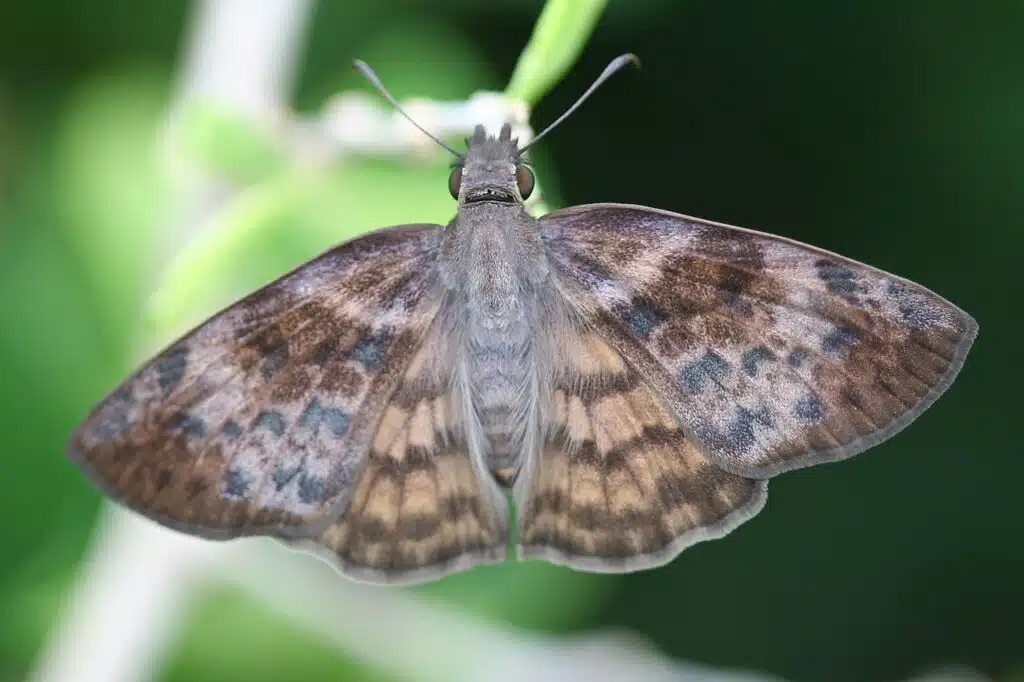
Seen in the Southeast US territories, the Brown-banded Skipper (Timochares ruptifasciata) is a widespread species with a constant presence in Central America and The Caribbean.
This species has light brown coloring with dark brown bands and patterns. The hindwings have distinct parallel brown lines while the upper wings show checkered dark brown patterns.
The body of the Brown-banded Skipper is mostly dark brown to black.
Dark brown also dominates the base color of the head and the antennae.
46. Wright’s Metalmark
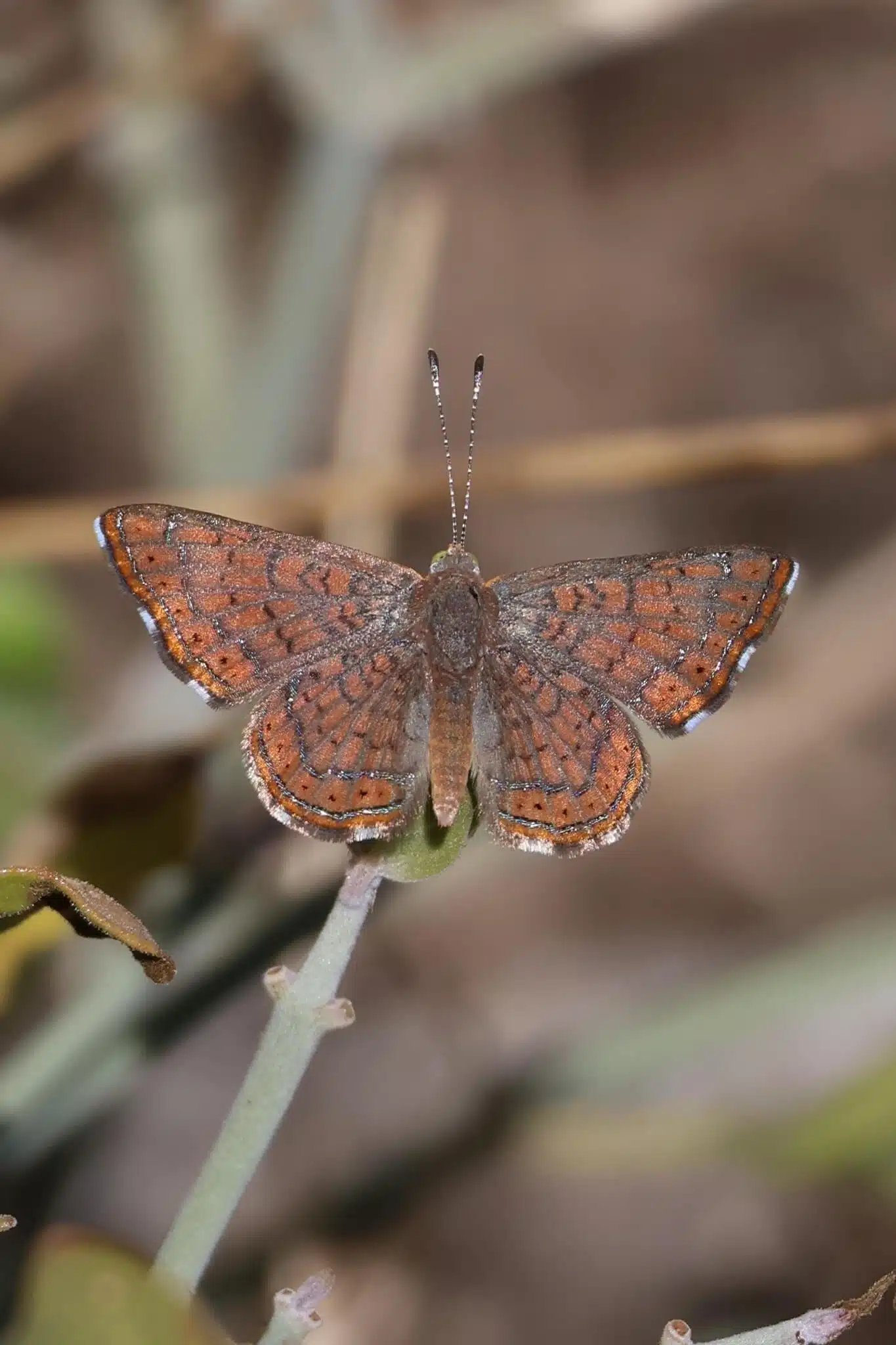
Seen around natural sources of water, Wright’s Metalmark (Calephelis wrighti) is native to Southwestern states such as California and Nevada.
This species has a dark brown base coloring of the wings and its body.
Black is the secondary color, mainly seen with the decorative stripes and lines across the wings.
White is the third color of the species. Its lower body has white overlays.
47. Swamp Metalmark
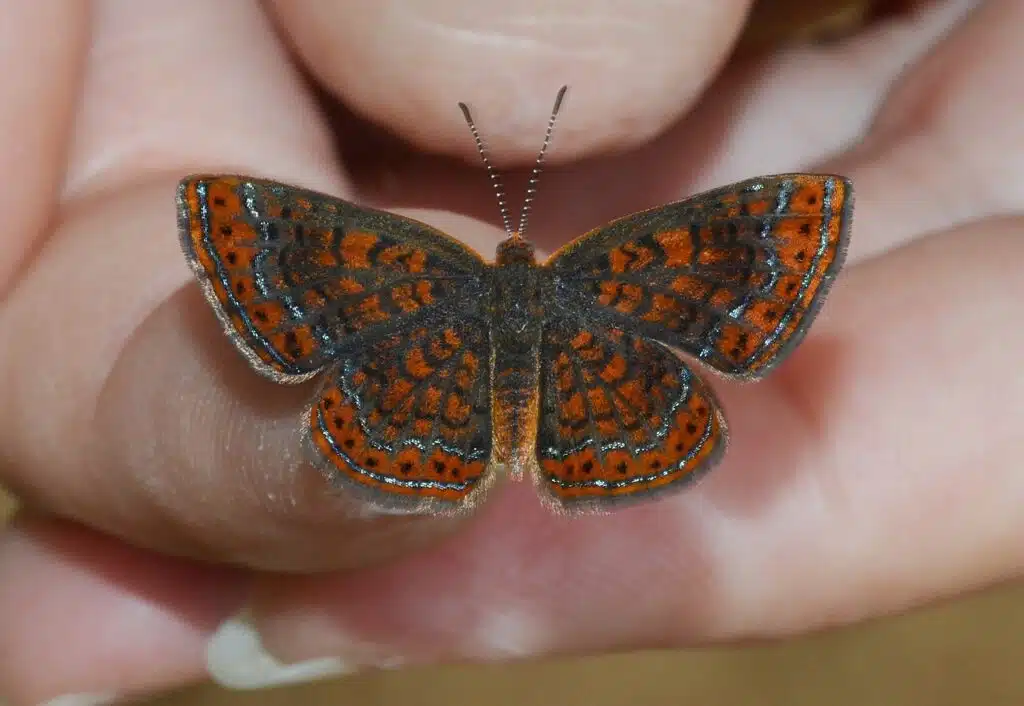
Swamp Metalmark butterflies (Calephelis muticum) resemble Wright’s Metalmarks but with extra white decorative patterns on the wings.
Dual white margins are seen across the wings of the species.
The habitat of the Swamp Metalmark is also different from the habitat of Wright’s Metalmark.
While both like to live next to water sources, Swamp Metalmarks are found further North in states such as Ohio where it feeds on black-eyed susans.
48. Dark Buckeye
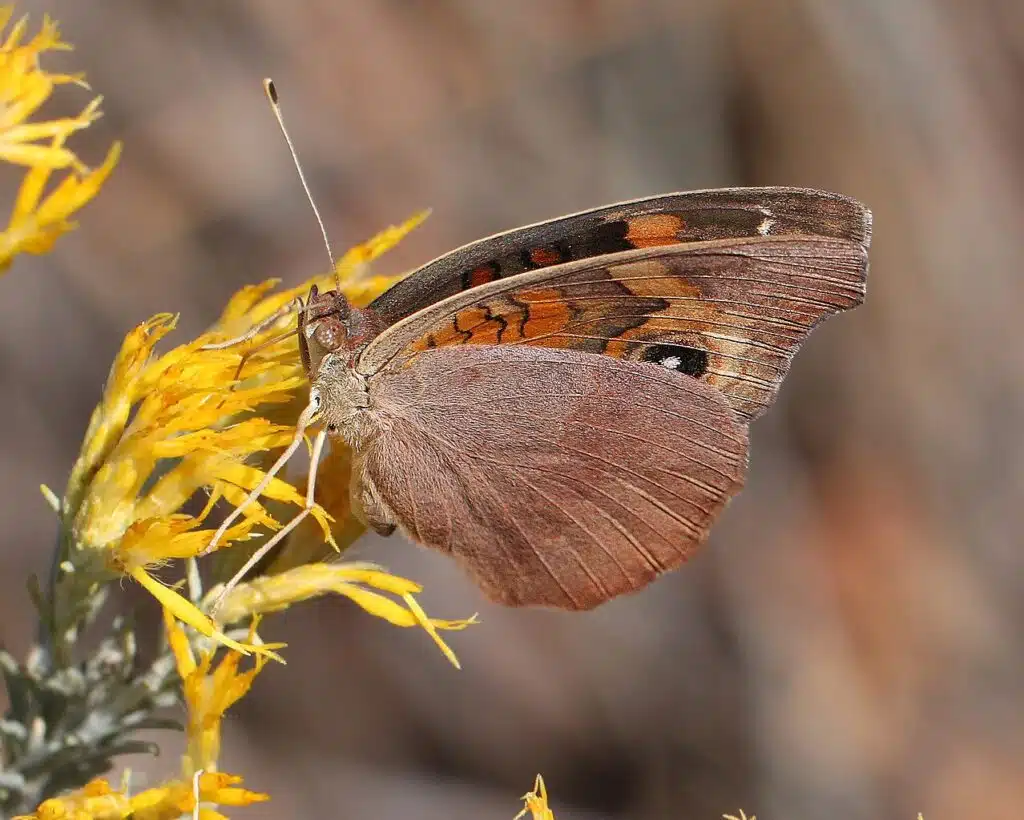
Native to Southwestern US territories, Dark Buckeye butterflies (Junonia nigrosuffusa) have brown, black, and light brown coloring.
Light brown-gray is specific to the hindwings which also show brown margins. The marks on the upper wings are also brown.
Dark Buckeye butterflies have dark upper wings which almost appear black.
The body of the species is also dark gray to black. The head of the Dark Buckeye is also brown while its antennae are white.
The species is prevalent in Central and South America.
Further Reading: